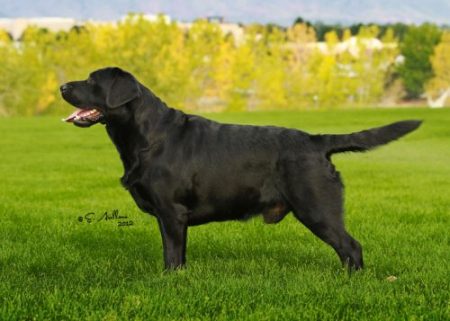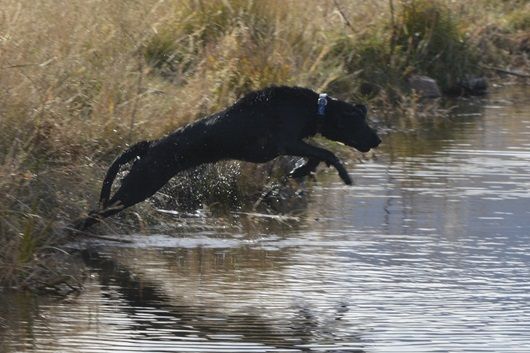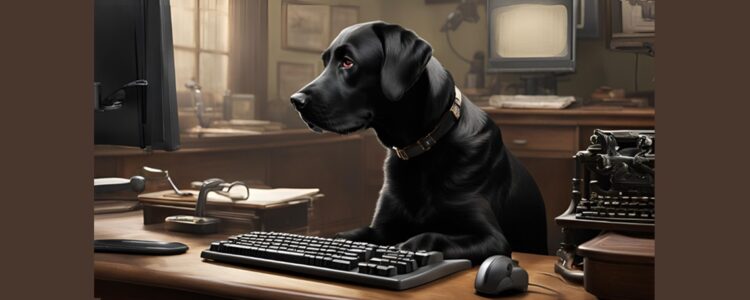
Browse this list of helpful links for Labrador Retrievers – clubs, competition, health issues, and more.
To request a link to a Lab club website or other helpful link or to update an existing link, please contact us.
National & International Dog Clubs
American Kennel Club (AKC)
Canadian Kennel Club (CKC)
Federation Cynologique Internationale (FCI)
The Labrador Retriever Club Inc
Master Amateur Retriever Club (MARC)
Master National Retriever Club (MNRC)
North American Hunting Retriever Association
Dog show info
List of AKC Licensed Dog Show Superintendents
Hunt test and Field trial entries
Health
American College of Veterinary Ophthalmologists (ACVO)
American Veterinary Medical Association
ASPCA Animal Poison Control Center, 24-Hour Emergency Number
888-426-4435
Animal Health Diagnostic Center
Genetic & Health Testing
US Labrador clubs
Dallas-Fort Worth Labrador Retriever Club
Greater Atlanta Labrador Retriever Club
Heart of Texas Labrador Retriever Club
Huron River Labrador Retriever Club
Labrador Retriever Club of Greater Denver
Labrador Retriever Club of the Pioneer Valley
Labrador Retriever Club of Southern California
Labrador Retriever Club of the Potomac
Mid-Jersey Labrador Retriever Club
Puget Sound Labrador Retriever Association
San Diego Labrador Retriever Club
Spirit of St. Louis Labrador Retriever Club
Winnebago Labrador Retriever Club
Lab links
Coat Color Inheritance in the Labrador Retriever
Other
Dog Lovers Bookshop (hard to find used, out of print and rare books)
Therapy Dogs International, Inc. (TDI)
Header image AI generated via Canva
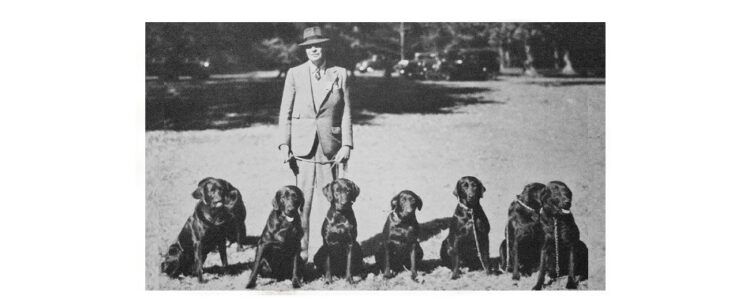
Jay Carlisle (and his Wingan Kennel) was “…undoubtedly the one to whom most credit is due for the rise in the popularity of Labradors in the U.S.A.”
– Labrador Retriever Club Yearbook, 1931-1944
Imagine, if you will, the sprawling mansions, huge parties, and nouveau riche of The Great Gatsby era. The Great War had ended, Prohibition brought speakeasies and organized crime, and the stock market crashed. It is in such a setting we find Jay Carlisle and his Wingan Kennel.
Born in Brooklyn in 1868, Carlisle was a stockbroker and the Governor of the American Stock Exchange during the 1929 crash. His wife was Mary “May” Pinkerton Carlisle. (Yes, that Pinkerton family.)
Carlisle was also a sportsman. His horses ran on the track or competed in shows. He rode to hounds and played polo. And he fished and hunted.
We pick up his story when Carlisle turned his attention to Labrador Retrievers.

Image courtesy East Islip Historical Society – www.eastislip.org
Step 1 – Import the Best Labradors
Jay Carlisle liked a good-looking dog, but he wanted more. He wanted dogs with an acceptable show record and qualified in the field. “Once Mr. Carlisle had decided that the Labrador was to be his breed, he began a study of existing blood lines. He went over countless records, and all the time he had in mind the qualities that he wanted.” 1
After breeding, raising, showing, and racing horses, he developed a discerning eye. However, in the early 1930s, the Lab was still new to America and field trials were just getting started. Carlisle promised to make the breed as popular in America as it was in Britain.
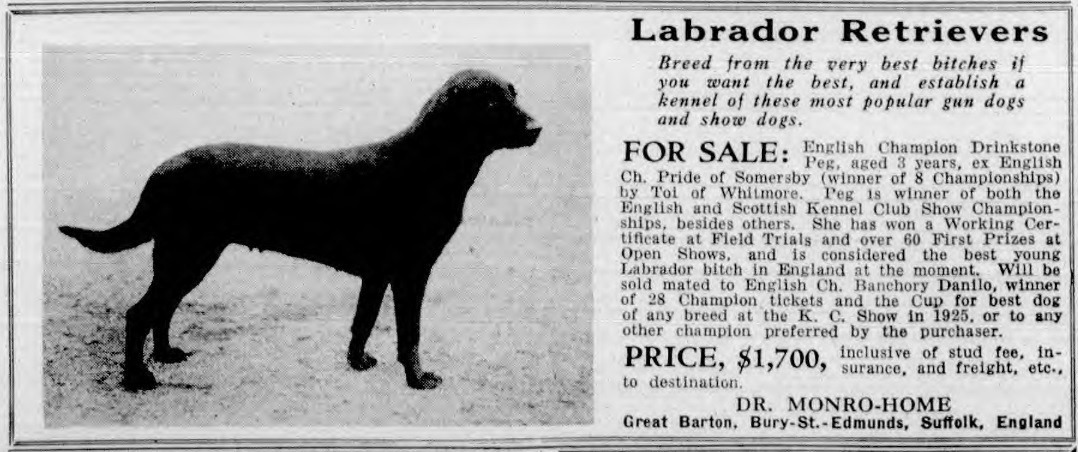
Peg was offered for sale for $1700. Today’s equivalent is about $30,000.
After researching, he imported nine of the finest Labs to start his kennel. The best of these was English Champion Drinkstone Peg of Wingan. She was born in 1927 and bred by Dr GH Monro-Home of Scotland.
Of the other eight Labs, three came from Lorna, Countess Howe.
Eng Am CH Drinkstone Peg of Wingan
Peg was sensational in the show ring and earned nine Challenge Certificates which are similar to ‘winning the points’ in America. Three certificates were enough for a championship, but she kept on winning.
In England there is a ‘show championship’ and a ‘full championship’. A full championship requires the dog to prove it can work in the field as well as win in the show ring. Peg earned her working certificate at the International Gun Dog League retriever trails in 1930 and became a full champion.
She also won her show championship in America. But despite being a top show dog, Carlisle was more interested in Peg’s potential for breeding. Of course the male is also important so he had her bred to Dual Champion Bramshaw Bob. He was one of England’s greatest show dogs and stud dogs.
Two months later Peg whelped seven puppies at Carlisle’s Wingan kennels.
After raising her puppies, she went back into the show ring and continued winning. One of her big wins was Reserve at the Westminster Kennel Club show in 1934.
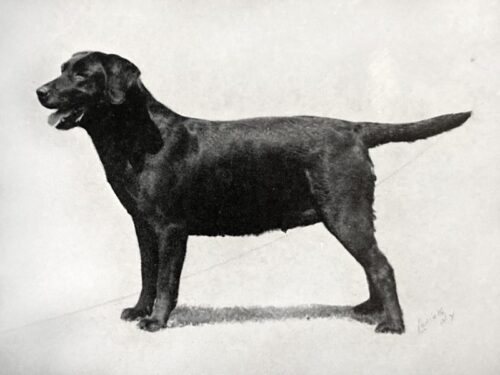
| Eng Am CH Drinkstone Peg of Wingan black female, born 4/18/1927 |
Toi of Whitmore FTW | Tyg of Whitmore |
| Bute of Trentham | ||
| Eng CH Pride of Somersby | Brayton Siddy | |
| Juno of Somersby FTW |
CH Drinkstone Pons
Another dog Carlisle imported was Drinkstone Pons. He was Peg’s son sired by English Champion Banchory Danilo and bred by Dr Monro-Home.
Pons started his show career as a puppy. He won many prizes and was often chosen as the best Labrador, best retriever and/or best gun dog. Pons won Best of Breed at the Westminster Kennel Club show – twice – and also won second in the group competition. He won Best in Specialty Show at the annual Labrador Retriever Club Inc. show.
In 1934 he started running and placing in field trials. He won the Open novice stake the the Brookhaven Game Protective Association trial with kennel mates Night Light and Ben taking second and third. A New York Times reporter said “The placed dogs showed the influence of the highest breeding, combined with thorough training. All the Wingan representatives exhibited intelligence in their hunting, with a minimum of direction from their handler.” 2

| CH Drinkstone Pons of Wingan black male, born 5/11/1931 |
Eng Ch Banchory Danilo FTW | Eng Dual Ch Banchory Bolo |
| Munden Scarcity | ||
| Eng Am Ch Drinkstone Peg of Wingan | Toi of Whitmore FTW | |
| Eng Ch Pride of Somersby |
Drinkstone Mars
Mars was another outstanding dog. He often won in the show ring and earned his certificate of merit under judges Countess Howe and the Honourable Mrs. Hill Wood.
Pons and Mars were littermates and won the brace class together. Mars won the points toward his show championship at the Labrador Retriever Club Inc. specialty show in 1934. And as a dual purpose Labrador, he also won in field trials.

| Drinkstone Mars of Wingan black male, born 5/11/1931 |
Eng Ch Banchory Danilo FTW | Eng Dual Ch Banchory Bolo |
| Munden Scarcity | ||
| Eng Am Ch Drinkstone Peg of Wingan | Toi of Whitmore FTW | |
| Eng Ch Pride of Somersby |
CH Liddly Bulfinch of Wingan
Bulfinch was another import and was bred by H.A. Richardson. He won about 50 times at championship shows and certificates of merit at field trials.
And he won the points at the Labrador Retriever Club Inc. annual specialty show in 1935. This means he defeated the other non-champion males and earned points toward his show championship.
Bulfinch completed his championship with a 4-point win at the Long Island Kennel Club show in May 1936.
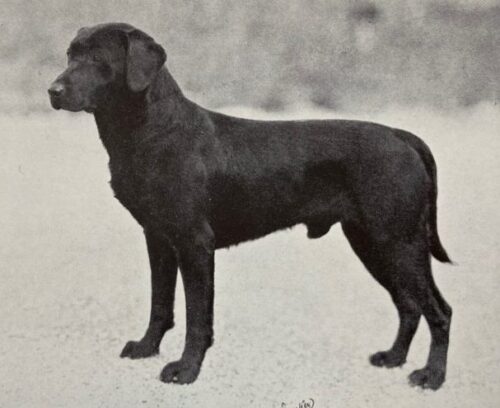
| CH Liddly Bulfinch of Wingan black male, born 2/7/1932 |
Eng CH Tar of Hamyax | Toi of Whitmore FTW |
| Sunshine of Fasham | ||
| Delyn of Liphook | Eng CH Banchory Danilo FTW | |
| Ridgeland Black Diamond |
FC Banchory Night Light & CH Banchory Jetsam
Banchory Night Light and Banchory Jetsam were littermates sired by Blackworth Midnight. They were bred by Miss L. Croad of England.
In 1935 Field and Stream Magazine began offering a challenge trophy to the dog that earned the greatest number of points. Only competition in Open All Age Stakes counted.
Night Light was one of the top Labradors and earned 12 points in the contest. Banchory Varnish of Wingan earned 10 points and Glenairlie Rover was tied with Blind of Arden at eight points.
He was a Field Champion and major pointed in dog shows. Jetsam was a Show Champion which included winning the points at the Westminster Kennel Club show in 1934.
Tops of Bigstone, Night Light’s daughter, produced several quality dogs. These included Dual CH AFC Matchmaker for Deer Creek, FC AFC Ladies Day at Deer Creek, and Kingdale’s Ink Spot.
It’s interesting that Night Light carried the chocolate gene while his sister, Jetsam, carried the yellow gene.
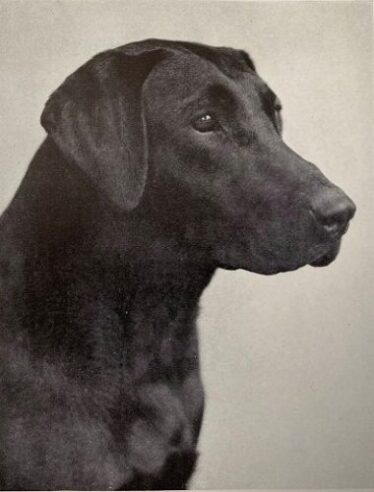
FC Banchory Night Light of Wingan

CH Banchory Jetsam
| FC Banchory Night Light of Wingan black male, born 1/1/1932 CH Banchory Jetsam black female, born 1/1/1932 |
Blackworth Midnight | Eng CH Wilworth Rip |
| Brookstone Jet CCW | ||
| Dinah of Wongalee | Eng CH Beningbrough Tangle FTW | |
| Wendy of Wongalee |
Banchory Dapper
Banchory Dapper was a half brother of Night Light and Jetsam, all sired by Blackworth Midnight. He won a 5-point major at the Labrador Retriever Club Inc. specialty show in 1934.
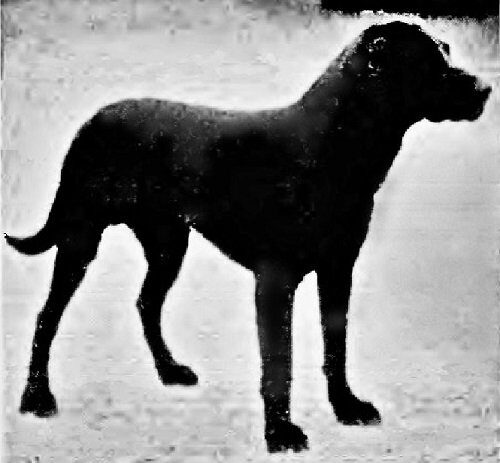
| Banchory Dapper black male, born March 1932 |
Blackworth Midnight | Eng CH Wilworth Rip |
| Brookstone Jet CCW | ||
| Banchory Student | Eng CH Banchory Danilo | |
| Eng CH Pride of Somersby |
Orchardton Doris of Wingan
Orchardton Doris was bred by S.H. Carruthers and worked as a field dog in Scotland.
After coming to America she was described as “a high class bitch with beautiful style, great pace and very keen… She and her handler, Dave Elliot, gave a beautiful exhibition of giving and taking direction to an unmarked fall by hand and whistle, without undue disturbance of ground on either side. She has an invariably excellent pick-up, carry and delivery.” 3
A fast and expert retriever, Doris also had several wins in the show ring.
She was the mother of Pons Junior of Wingan and Wingan’s Daily Double and the grandmother of FC Timber Town Clansman.

| Orchardton Doris of Wingan FTW black female, born 12/31/1930 |
Eng Ch Ingleston Ben | Duke of Kirkmahoe FTW |
| Ingleston Nancy FTW | ||
| Orchardton Dawn | Eng CH Brocklehirst Donner | |
| Hardies Choice |
Eng Sh CH Am CH Banchory Trump of Wingan
The ninth dog, Banchory Trump, stayed in England until he finished his show championship. After coming here, he finished his American show championship with Best of Breed wins at the Westminster Kennel Club dog show and at the Labrador Retriever Club Inc. specialty.
He won numerous Bests of Breed awards and placed in the group several times.
His Best of Breed winning streak included several very competitive shows:
- Morris & Essex, 5/23/1936
- The Labrador Retriever Club Inc, 6/27/1936 – Best In Specialty Show
- Morris & Essex, 5/29/1937
- The Labrador Retriever Club Inc, 6/18/1937 – Best In Specialty Show
- Westminster Kennel Club, 2/10-12/1938
- International Kennel Club, 4/2-3/1938
- Leavenworth Kennel Club, 4/27-28/1938 – Best Of Breed and Group 3rd
- Des Moines Kennel Club, 11/12-13/1938 – Best Of Breed and Group 4th
Trump sired females that passed on excellent genetics. Bred to CH Bancstone Lorna of Wingan he produced Huron’s Lady, the mother of Dual CH Grangemead Precocious. When he was bred to a daughter of Eng FTCh Banchory Varnish of Wingan he produced Peggy of Pheasant Lawn. Peggy was the mother of FC Pickpocket for Deer Creek and Bancstone Dinah, grandmother of NFC AFC Massie’s Sassy Boots.
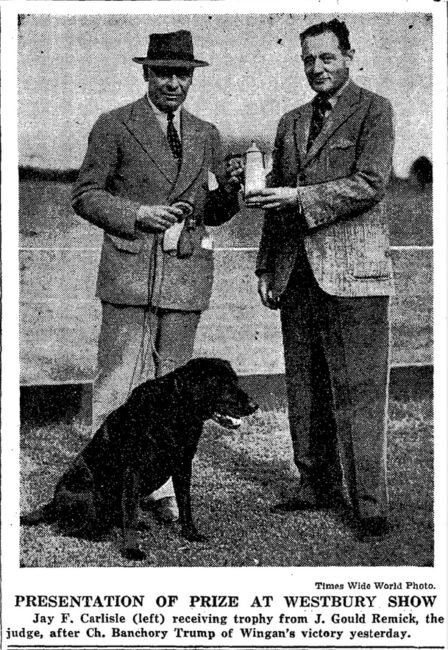
| Eng Sh CH Am CH Banchory Trump of Wingan black male, born 8/21/1931 |
Blenheim Scamp FTW | Balwearie |
| Blenheim Lady | ||
| Lady Daphne | Saffrons Bob CCW | |
| Haste |
Drinkstone Peg’s British litter
Below are Peg’s puppies by Eng Dual Ch Bramshaw Bob.
| Litter bred in England and born in America Born 8/7/1933 |
Eng Dual Ch Bramshaw Bob | Eng Ch Ingleston Ben |
| Eng FTW Bramshaw Brimble | ||
| Eng Am Ch Drinkstone Peg | Eng FTW Toi of Whitmore | |
| Eng Ch Pride of Somersby |
CH Bancstone Ben of Wingan
Owned by J.F. Carlisle
Ben placed in field trials and also did very well in shows. He finished his show championship with multiple five-point majors.
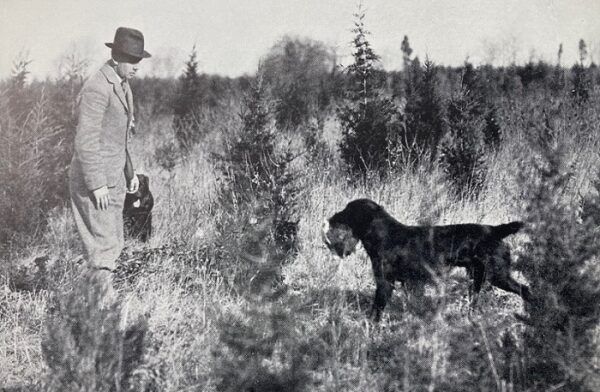
Bancstone Blair of Wingan
Owned by J.F. Carlisle
Although he wasn’t shown much he almost always won his class and even won Best of Breed.
CH Bancstone Bob of Wingan
Owned by J.W. Redmond
Bob also finished his show championship with three five-point majors – including at the Westminster Kennel Club dog show in 1937.
Bancstone Doctor of Wingan
Owned by J.F. Carlisle
Although Doctor was also shown, he didn’t finish his championship.
CH Bancstone Countess of Wingan
Owned by J.F. Carlisle
Countess won Reserve Winners Bitch at both the Westminster Kennel Club dog show and the Labrador Retriever Club specialty show. She finished her championship title with two 5-point and two 4-point major wins.

CH Bancstone Lorna of Wingan
Owned by J.F. Carlisle, later by James R McManus
Another Wingan-bred show dog that finished her championship with three 5-point majors. And she won Best in Specialty Show at the Labrador Retriever Club specialty show in 1935.
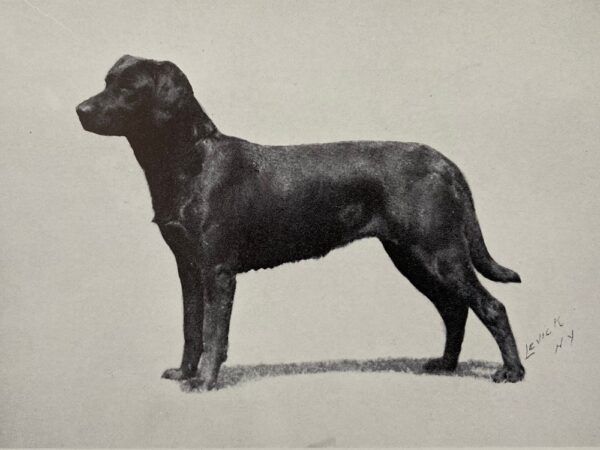
Bancstone Peggy of Wingan
Owned by J.F. Carlisle, later by C.H. Mackay
Although she was halfway to her show championship, it appears she never finished her title.
Other Labs
Carlisle had many dogs – some he bought and some he bred. Here are a few of his better known Labs.
Eng FTCh FC Banchory Varnish of Wingan
Owned by J.F. Carlisle, later by Mrs. Kathleen B. Starr (Timber Town)
In April 1937 Varnish won the Open all-age stake at the Long Island Retriever Field Trial Club. He was described as “consistent in his work throughout a long day … in which champions and top field-trial dogs fell by the wayside.” He “did all that was asked of him in his work on land, quartering, taking direction, showing intelligence in his questing and exhibiting nose for his game.” 4
He also won the Open stake at the Brookhaven Game Protective Association trial in the fall of 1937. “In the second series, his first bird was easy; but the second was dropped across the road in back of motor cars and gallery. The dog worked out the problem, however, and retrieved the bird in grand shape. In the third series, his speed and precision could not possibly escape the notice of the judges while his marking was exceptional.” 5
The gallery cheered their old-time favorite.
Varnish was also pointed in the show ring.

| Eng FTCh FC Banchory Varnish of Wingan black male, born May 1933 |
Eng Dual Ch Banchory Painter | Eng Ch. Peter the Painter |
| Glenhead Bess | ||
| Hawkesworth Glimmer | Banchory Tealer | |
| Bramshaw Gloss |
Pons Junior of Wingan
Pons Junior won the Brookhaven amateur trial handled by Mrs. Kathleen B. Starr (Timber Town kennels). He was described as making “two grand retrieves in the water test, going out on a surveyor’s line to both ducks.” The stake was judged by Colonel the Lord Vivian, D.S.O., of Britain, and David Wagstaff of Tuxedo Park, NY. 6
He also did well in the show ring including winning Reserve Winners Dog at the Westminster Kennel Club dog show in 1937.
A year later Timber Town Clansman, his two-year-old son, won the Women’s Field Trial Club non-winners stake.
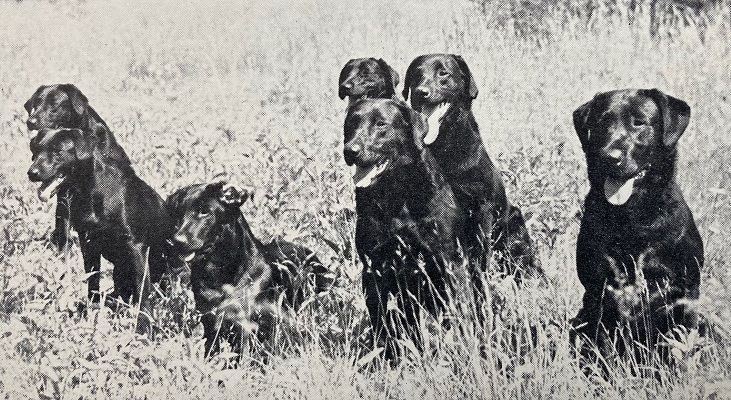
Rear, left to right: Pons Junior, Ebony of Barrington, Banchory Night Light, CH Drinkstone Pons. Front: Whitecairn Wendy, Banchory Varnish, CH Bancstone Ben.
| Pons Junior of Wingan black male, born 4/30/1934 |
Drinkstone Pons of Wingan | Eng FTCh Banchory Danilo |
| Drinkstone Peggy | ||
| Eng FTW Orchardton Doris of Wingan | Eng Ch Ingleston Ben | |
| Eng FTW Orchardton Dawn |
Okanagan Sandy
Sandy was bred in Canada and was special enough to earn a place at Wingan Kennels. One of the field trials he ran was under particularly difficult conditions.
“Six dogs were called back for the final elimination with the sea pounding on the outer bars, whitecaps making in the inlet and snow squalls driving inland. Dog after dog was sent into the icy water. Suddenly the black clouds closed down and the whole world was shut out by a driving snowstorm….
“Sandy’s water work was little short of perfection, he taking to the water with a huge splash, after having marked his two falls…” 7
| Okanagan Sandy black male, born 4/5/1934 Bred by R. Leckie Ewing, Canada |
Beaver of Bryn | Banchory Jock |
| Munden Stigma | ||
| Gay’s Vesta | Eng Nat’l FTCh Beningbrough Tanco | |
| Eng FTCh Vidi of Adderley |
Okanagan Tanco
Tanco was another import from Canada. In November 1936, he won the Derby stake at the Labrador Retriever Club trial in Peapack, NJ.
As the winner, he brought home the directors’ trophy and $25. Although that doesn’t sound like much it’s the equivalent of over $500 today.

| Okanagan Tanco black male, born 6/17/1935 |
Okanagan Rusty | Beaver of Bryn |
| Okanagan Gyp | ||
| Gay’s Vesta | Eng Nat’l FTCh Beningbrough Tanco | |
| Eng FTCh Vidi of Adderley |
Orchardton Duce of Wingan
Owned by Jay Carlisle, later by Mrs Eleanor F. Remick
Duce won the Labrador Retriever Club’s Derby stake at 14 months old. Colonel the Lord Vivian, D.S.O., of Cornwall, England judged together with Dr. Samuel Milbank and Francis Squires. The trial was held at Shinnecock Hills in Nov 1937.
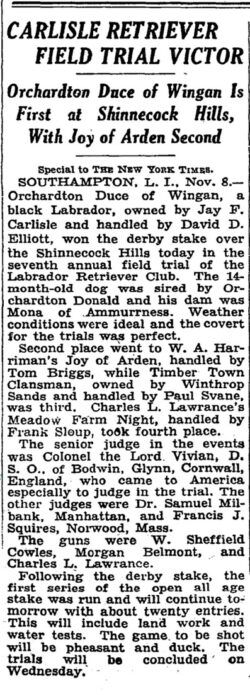
| Orchardton Duce of Wingan black male, born approximately Sep 1936 |
Eng Ch Orchardton Donald | Eng Ch Ingleston Ben |
| Orchardton Dawn | ||
| Mona Of Ammurrness | Eng FTCh Tag of Clava | |
| Queen of the May |
Whitecarin Wendy of Wingan
Owned by Jay Carlisle
Wendy won the Open stake at the Brookhaven Game Protective Association field trail in 1935. The weather was described as “almost ideal, the thermometer hovering around the freezing mark, and the wind was just strong enough to make it a sporting proposition for guns and dogs.” 8

| Whitecarin Wendy of Wingan black female, born approximately 1933 |
Ranger of Kentford | Gift of Halleaths |
| Kirkbean Gyp | ||
| Lochar Kate FTW | Eng Dual Ch Banchory Bolo | |
| Murrayfield Bet |
Wingan’s Daily Double
Another Wingan dog deserving of mention is Daily Double. Bred by Carlisle and sold to Howes Burton, an amateur, who handled her himself. She won at the Long Island Retriever Field Trial Club in 1939 and placed second in what was called “fast company” just a week before. The winner in that trial was Earlsmoor Moor of Arden.
However what makes her special is the combination of pedigree and offspring. She was a half-sister to Blind and Decoy of Arden on her father’s side. And a half-sister to Pons Junior on her mother’s side.
When bred to Eng FTCh Glenairlie Rover, she produced Mint of Barrington who in turn sired NFC AFC Marvadel Black Gum “Blackie”.
Blackie was High Point Derby dog in 1946. He won his first Open stake at 16 months of age and finished his field championship the next year. And he qualified for eight consecutive National Opens (1946-1953), winning in 1949.
| Wingan’s Daily Double black female, born 7/9/1936 |
Odds On FTW | The Favorite FTW |
| Jest | ||
| Orchardton Doris of Wingan FTW | Eng CH Ingleston Ben | |
| Orchardton Dawn FTW |
Step 2 – Build the Best Kennels
Instead of a heated kennel building with attached runs, Jay Carlisle built condos for his Labs. He felt it would be hard for the dogs to go from a heated kennel to retrieving in icy water.
Each condo was 6×11 feet, made out of redwood and set on 4x4s to avoid rot. Inside were two rooms – a 5×6 foot vestibule that became a shaded porch in summer and a 6×6 foot sleeping compartment with a hallway to avoid drafts.
They even had lights, windows and a hinged roof for cleaning.
The condos were set in 20×30 foot concrete runs with trees for shade. Puppies had a similar set up in a larger grass run.

Nearby was the feed house where they stored supplies and prepared meals for the dogs. Puppies were fed five meals a day – cereal with milk in the morning, cooked beef, raw beef, milk and biscuit and a big-dog meal.
Adult dogs got cooked meat twice a week with commercial food, cod liver oil and yeast. Occasionally they got salmon or raw beef.
Step 3 – Import the Best Help
While Jay Carlisle was looking for the best Labs, he was also looking for someone to train the dogs. For that he looked to Scotland where many men learned the business as kennel men and game raisers.
With the help of Countess Howe and many others, Carlisle found the right man. In 1934 he brought David D. Elliot to Long Island from Scotland.

A few months later at the Brookhaven Game Protective Association trial they swept all three places in the open novice stake. Drinkstone Pons of Wingan won $50 for first place. That’s over $1000 in today’s currency. Second place and $30 to Banchory Night Light of Wingan. Third place and $20 to Bancstone Ben of Wingan.
Carlisle did indeed find the right man to run his kennel.
David D. Elliot
Elliot grew up near Edinburgh, Scotland, where he learned about sheepdog trials from his grandfather. Watching how the sheepdogs responded to signals gave him the idea to teach signals to Labs. A form of these signals is still used today to guide dogs on blind retrieves.
Lady Howe, Dr. Monro-Holm and David Black (breeder of Peter of Faskally) recommended Elliot as a kennelman for Carlisle. Elliot agreed to come for five years, but instead, he stayed for a lifetime.
In addition to training dogs, he also trained people. They included Dorothy Howe (Rupert), Joan Redmond (later Joan Reed, Chidley) and Kathleen Starr (later Mrs Fredricks, Timber Town). The ladies were sometimes called “Elliot’s Harem.” Cotton Pershall was another person who learned how to handle dogs at Wingan.
Carlisle was pleased with Elliot’s training and thanked him for introducing him to field trialing. The competition made him happy despite the recent death of his wife.
If you’d like to see Elliot and two of his retrievers – Eng FTCh FC Banchory Varnish of Wingan and FC Timber Town Clansman – check out the “Sky Game” video, filmed in 1939.
Step 4 – Promote the Kennel and Competition
Jay Carlisle registered Wingan as his kennel name in 1933.
He ran ads in a variety of magazines – from the AKC Gazette to Vanity Fair.

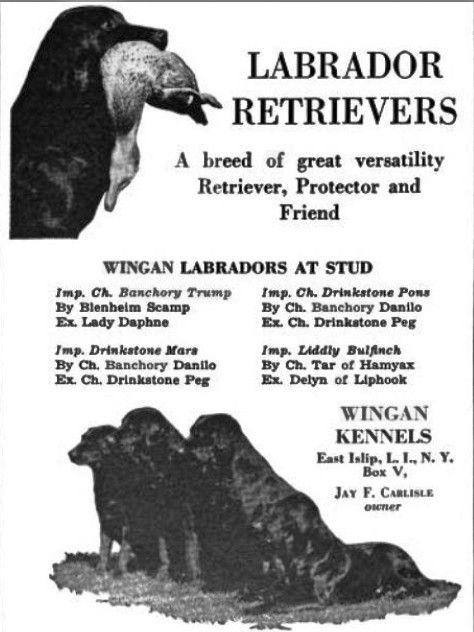

He served as President of the Labrador Retriever Club from 1935-1938. During that time he established the Amateur stake and donated a perpetual trophy so the stake would continue.
Carlisle, Anthony Bliss, Franklin Lord, Gould Remick, Henry Root Stern, and Leonard Buck formed the Long Island Retriever Trial Association. The club’s purpose was to encourage the breeding, training, and use of retrievers, and for holding of all-breed retriever trials.
David Elliot wrote a book about Labs and training them and Carlisle published it in 1936. It included training advice and many photos of Wingan Labradors.
“The efforts and absorbing interest of J. F. Carlisle, his participation in trials and at shows, and his generous offering of dogs at stud to new breeders gave the breed a tremendous push forward in this period. He helped to form a nucleus of good material to build upon, together with the superb group of imports… All this gave the breed the right start, and it was not long before history repeated itself, so that the Labrador was on its way to overtaking all the other Retriever varieties in the New World, as it had in the Old.” 9
The End and a Beginning
Jay Carlisle died in 1937, just eight months after his wife.
He was so respected, that 28 prominent men volunteered to act as pallbearers. A special train transported guests from Penn Station in New York City to Carlisle’s home in East Islip, Long Island.
The retriever community postponed a field trial so contestants could attend his funeral. However the postponement meant the trial had to be limited in order to finish in one day. This was the start of Limited All-Age stakes.
The Labrador Retriever Club, Inc. set up a Jay Carlisle Memorial Trial. It was held from 1938 to 1941 near his home on Long Island. Mrs. Hill-Wood, Morgan Belmont and Robert Morgan judged the first Memorial Trail.
On a sad note, the contents of his home went to auction in 1938 and his beautiful mansion was demolished in 1940.
Most of his dogs were given to the young Scotsman, David D. Elliot. He also received the specially-modified green and yellow dog wagon and the right to rent the Wingan kennel at a reduced rate.
Although it seems like a sad ending, the dogs did continue competing with Elliot. And many people recognized Carlisle’s contribution to Labradors and to field trials in America.
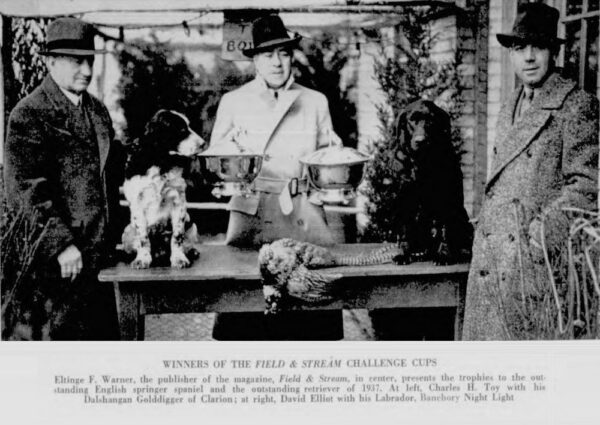
David Elliot (right) with Banchory Night Light winning the Field & Stream Challenge Cup for Outstanding Retriever of 1937.
Today
Few people recognize the Wingan name today or they confuse it with Helen Ginnel’s Whygin kennel. But Carlisle’s efforts – importing quality dogs, making his stud dogs available, and promoting Labradors – helped make the breed as popular in America as it was in England.
I’m proud to have several dogs that trace back to the Wingan Labradors.
— Chip and his descendants trace to –
* NFC Banchory Night Light of Wingan (grandsire of Dual CH Matchmaker for Deer Creek)
* Am Eng CH Banchory Trump of Wingan (grandsire of Dual CH Grangemead Precocious and FC Pickpocket for Deer Creek)
* CH Bancstone Lorna of Wingan (granddam of Dual CH Grangemead Precocious)
* Penney of Wingan (dam of NFC AFC Massie’s Sassy Boots)
— Dee and her descendants trace to –
* CH Banchory Jetsam
* NFC Banchory Night Light of Wingan (grandsire of Dual CH Matchmaker for Deer Creek)
* Am Eng CH Banchory Trump of Wingan (grandsire of Dual CH Grangemead Precocious and FC Pickpocket for Deer Creek)
* Eng FTCh FC Banchory Varnish of Wingan
* CH Bancstone Lorna of Wingan (granddam of Dual CH Grangemead Precocious)
* Bancstone Blair of Wingan (grandsire of NFC NAFC CFC Major VI, 1993 Hall of Fame)
* CH Bancstone Peggy of Wingan
* Eng Am CH Drinkstone Peg (dam of the Bancstone litter by Eng Dual CH Bramshaw Bob)
* Orchardton Doris of Wingan (dam of Pons Junior Of Wingan and Wingan’s Daily Double)
* Pons Junior of Wingan (sire of FC Timber Town Clansman and great grandsire of NFC Dual CH CFC Bracken’s Sweep)
* Wingan’s Daily Double (granddam of NFC AFC Marvadel Black Gum)
Notes:
[1] Arthur Frederick Jones, “True Labradors and Traditions Live at Wingan,” American Kennel Gazette, February 1934
[2] Henry R. Ilsley, “Carlisle’s Entries Take All Three Places in Open Novice Retriever Stake,” New York Times, December 29, 1934
[3] Helen Warwick, “The Complete Labrador Retriever” (New York: Howell Book House, 1965), 137
[4] Staff correspondent, “Carlisle’s Labrador Beats 22 Dogs in Long Island Retriever Clubs Trial,” New York Times, April 18, 1937
[5] Ned Corey, “Banchory Varnish of Wingan First in Brookhaven All-Age,” American Kennel Gazette, December 1, 1937, 94
[6] Staff correspondent, “Brookhaven Field Trials Are Marked by Splendid Work and Keen Competition,” New York Times, October 31, 1937
[7] Henry R. Ilsley, “Retriever Laurels Annexed by Carlisle’s Dog at Trials Held in Snowstorm,” New York Times, November 29, 1936
[8] A.F.J., “Whitecairn Wendy of Wingan Wins Brookhaven’s Open Stake,” American Kennel Gazette, January 1, 1936, 168
[9] Warwick, “The Complete Labrador Retriever,” 126
Glossary:
- AFC – Amateur Field Champion
- Best of Breed – At a dog show, the dog that has defeated all the other dogs of its breed.
- Best of Opposite Sex – If a male dog wins Best of Breed, the best female wins Best of Opposite Sex, and vice versa.
- BLF / BLM – Black Labrador female or black Labrador male
- Brace class – Two dogs shown together that look very much alike.
- CCW – British Challenge Certificate winner (show win, but not a title).
- CH – Dog show championship
- Dual Champion – A dog that has won a show championship AND a field championship.
- English show champion (“Eng Sh CH”) – A dog that earned a show championship, but lacks the working certificate to be a full champion.
- FC – Field Champion (British FTCh) – A dog that has won enough in field trials to qualify for the field champion title.
- FTW – Field trial winner (not a title)
- Full champion – England requires Labradors to pass a working test in addition to earning a show championship.
- Major points – In the US, Winners Dog and Winners Bitch can each receive points based on the number of dogs defeated. It can be 0-5 points, with 3 to 5 point wins called “majors.”
- NFC – National Field Champion
- QAA or *** – A dog that has proved himself in the Qualifying stake and could enter the limited Open or Amateur stakes.
- Reserve Winners – The second best dog of its sex that has not completed a show championship.
- Winners (also Winners Dog or Winners Bitch) – In the show ring, males (“dogs”) compete against other males in various classes. Then the winner of each class competes against the other winning males for Winners Dog. Depending on the number of males defeated, the Winners Dog will receive up to 5 points towards his show championship. It works the same for females.
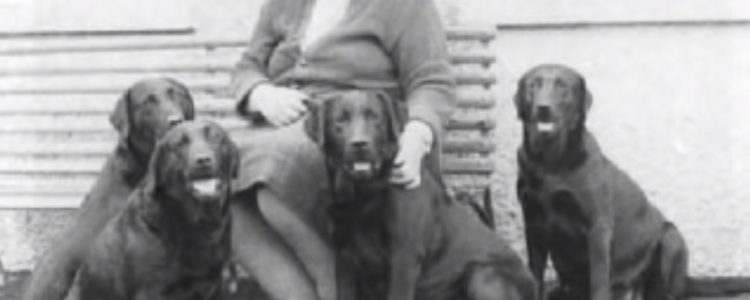
Mary Roslin Williams of Mansergh Gundogs
She bred Labs, she hunted over Labs, she competed with Labs and she taught about Labs. She had seven generations of champions, and 15 or so dogs who won field trial awards.
In the early days, she lived in Mansergh Parish, just south of the Lake District in England.
Mary Roslin Williams taught from practical experience and common sense.
Although she’s no longer with us, she left behind knowledge that she shared. Read a bit and then take a half hour to listen.
The start of the show/field divide
“I started this book by pointing out that at any one time there are about twenty top breeders who can and do stay at the top for many years, but when I come to the breeders who can show their dogs as Championship show-prize winners and also run them in Trials as Trial dogs, accepted as such by the Trial people and not called ‘Bl—y show dogs’ as is their wont, then I find it hard to name twenty kennels that can do this in the last forty years.
“Before the last War there were plenty of strains capable of doing this, indeed it was more or less the norm. The whole atmosphere of Labrador breeding was different, with such people as Lorna, Countess Howe seeing to it that the show Labrador remained a working dog. … The dogs were good-looking on proper Labrador lines, they were thoroughly experienced shooting dogs and cut out their own work with the minimum of help from their handlers, although always ready to take the hint when they were stuck. The good work on the day was put in by the dogs and not the handlers, and while Lady Howe was alive this happy state of affairs, when Trials were fun and you and your dogs welcome, remained until the sad day she died, when we immediately feared and experienced the Great Divide, into entirely show bloodlines and entirely Field Trial, poles apart.”
A water dog
“It’s a great sadness to me, that when they named the Labrador they didn’t call it the ‘Labrador Water Retriever’ … because we forget that the dog is a water dog.
“It’s job was water work. It’s job still is water work and we’ve adopted it and adapted it for different works. But in many countries that we sell our puppies to … they expect that dog to work in water. Very largely. And if you sell a dog to Canada it will be working in water in terrible frost. In cold water. Hours at a time. We ought to remember that, both when we breed and when we judge….
Defining type
“The next thing is the Labrador is a Labrador. Now here is a difficult thing because this is type and however much you have a standard, one thing it cannot describe is type. You’ve got to have type in your head. … Perhaps type varies a little from country to country. …
“My criterion for Labrador type is a very simple one. It must look like a Labrador. It mustn’t look like a Foxhound. It mustn’t look like a Pointer … It mustn’t look like a Golden Retriever. …
Pointer
“You get unmanageability. It’s an outward bound dog. It’s horizon is 300 yards away. It’s hind legs make it gallop because they can’t help galloping. It’s head is held too high. It’s elbow is angulated for a high head carriage and you don’t want it in a Labrador. We used to get it. And besides that we’ve always got a very, very short coat.”
Foxhound
“The Foxhounds came in deliberately. … And what came with it? Arrogance… When he went to judgment, instead of looking at you like a Labrador should – they did that (turned head away) – with the proudest, most arrogant expression. Now that got into the breed very badly, so that we had championship show judges writing in their critique … correct arrogant expression…. It’s absolutely wrong.
“And the other terrible fault we got in there was that they were very fastidious. … They did not like opening their mouths in dirty water. I can’t blame them. I don’t like opening my mouth in dirty water. And I don’t intend to which is why I have a dog…”
Flatcoat
“Now the next thing that happened was that somebody realized this and they quietly moved in a Flatcoat. Now that did a power of good. But we had a Flatcoat influence. One of the reasons why I hate a black eye in a Labrador was that was brought in. We brought in narrow heads, Flatcoat eyes. Flatcoat shaped eyes. And we had a lot of feathering….
“Labrador breeders are so sensible they can get these things out. It took some years and we left the good points in. We lost the arrogance. We lost the hardness and we got dogs that would retrieve nicely again…”
Greyhound
“Now the next thing that came in – and I don’t know where it came in – and I could never get Ronnie Hill to tell me, but what he knew was that the trial people introduced Greyhound. And they introduced Greyhound purely to get the speed.
“Now that influence is still with us. And if you look at the trial Labradors, you’ll see that a lot of them have very, very beautiful necks and shoulders. Marvelous necks. Way, way beyond our reach of neck. Really beautiful necks and shoulders. And they have the deep body, then the tell-tale arch over the loin. And that is the most difficult thing to breed out, to get the field trial arch out of the loin. And then they have long, thin tails and single coats. …
“So I’m warning you, if you use field trial lines you get the virtues, you get the faults, but worse still you get their diseases. And this is why I am so against any Labrador looking like anything – or particularly feeling like anything – when you’re judging that isn’t a Labrador. But as you get in other breeds and you will get in diseases …
“So therefore my first Labrador has been a water dog. My second Labrador, for heaven sake, let it be a Labrador and let it look like a Labrador. Let it behave like a Labrador and feel like a Labrador and work like a Labrador.”
Importance of a correct coat
“… I do wish that everybody … would remember that the Labrador is a cold, wet weather dog and that he’s a water dog. And that it should be able to go out duck flighting in January in bitter, bitter weather sitting at the bottom of a cut in the sand with water up to its belly or even up to its neck. The tide coming in or out and it has to sit there for while the duck flighting in. A it is cold and it is wet and the dog must be able to stand it.
“…Please remember that that is the job of a Labrador. And they should have a proper coat. And it should coat them all over. [Some dogs] are half coated. They have a hard, hard ripple like a table runner down their backs. Very, very hard hair and they have nothing else. … And that is not a Labrador coat. The Labrador coat should cover all over to the same depth and be dense, but they’re very, very difficult to find now…
Why correct structure is important
“… a Labrador’s job is not to hunt in front of you, flushing rabbits, flushing pheasants, however good.
“It is not to be a guide dog for the blind.
“It is not to be a dog for finding drugs or any of these useful things [like] finding … a dead body… That’s not it’s job.
“It’s very nice of it to do it… but it is not it’s job.
“It’s job is to sit or walk at heel until told to go. And it’s only told to go either at the end of the drive or when the bird comes down if you’re in … a duck blind … and you want it to go. …”
A level back
“And for that you need a dog bred on exactly classical lines. And a classical line is a level back, not a rake. A level back. Any retrieving dog that has to also mark should have a level back. …
The neck
“It should have a longer back to its neck than to it’s throatline. … It should have an 11″ back to its neck and a 4″ throatline, not an 11″ throatline and 4” back.
“If it was a horse it would be putting it’s ear in your mouth…
“It’s very dangerous for a Labrador to have that enormous exposed windpipe… And then when they pick their bird, it stands to reason that… the long line is on the top and the short line is underneath.
The shoulders and angulation
“Now the shoulders should be laid back and this is very important too.
“In a pointing setter, they have a laid back shoulder. Fair enough. But they don’t have the classical right angle at the point of the shoulder. They are over angulated… We want the right angle or thereabouts give or take a few degrees.
“If you have a laid back shoulder, a right angle there and a level back … the foreleg comes back under the girth. It’s not under their ear and neither is it straight under the point of the shoulder. It is back and the elbow is under the girth.
“So there you have the exact angulation that the dog can easily mark the bird when he’s walking because it’s easy for him to have his head up. He can get a scent within a reasonable distance… and then put his head down. And he can get his head down perfectly easily without having to put his elbow out… So therefore you’ve got a perfect mechanism there.
“And he must have that long line on the top of his neck to pick his bird. He then picks his bird – which takes a lot of strength – and gets it back onto the layback of his shoulders easily carrying it on the layback of his shoulders.
“So if you have the classical front, that is exactly right for a Labrador, a Golden, a Flatcoat, a Curly, a Ches, but it isn’t right for a Pointer and Setter. And it isn’t right for a Foxhound. They have their own fronts, slightly open.
An example of why it matters
“… if you have an over angulated shoulder with open angles, like a Pointer and Setter – I’m citing one of my own dogs now.
“I had a lovely dog name Tarmac … and a very good worker. But I can cite him because he was wrongly made.
“He had a marvelously erect shoulder. He then had a raked back. And the consequence was that he was over angulated behind so that he had too much stifle and too much hock – too long a hock – and it was too far behind him. And that is what happens when you get a raked back.
“Now that was the most rightful inconvenience to him when he was swimming because he swam like a Pointer. …
“He was all right once he got the bird in his mouth, but when he didn’t have a bird in his mouth the fact that he didn’t have a level back and that he had an over angulated hind legs…, he had difficulty in the water work. So I know from experience that is not a good thing. …
“At one time because we had a craze for very, very short backs – which … is not short coupled, the word ‘short-coupled’ means the loin. … they were absolutely cramming dogs so close together that they had no where to put their feet when they ran. .. They were crabbing and they had a very short line … from the point of the hip to the point of the buttock, they had no rumps whatsoever.
“And I am quite certain for work – particularly swimming – you must have a decent balanced length from the point of the hip to the point of the buttock. …
Stance
“Now if you’ve got your backline right, then you’re going to have your angulation just about right.
“And it’s well to remember – again – that a Labrador is not meant to stand with it’s legs out behind it like a Pointer or a Setter. They’re meant to stand more or less under the point of the buttock. “In other words the dog is standing slightly over his leg and he mustn’t stand sickle-hocked with his feet too far forward.
“And a very important point, … for a perfectly balanced dog … from the hock to the ground … should be at exact right angles to the ground – not stretched out back, nor sickle underneath. …
“If that dog drops it’s hock correctly, then it is standing absolutely correct on it’s feet and you’re less likely to have foot trouble.
“… If you’ve got your angulation right and your level back, you’ve got a balanced dog standing on it’s feet correctly with it’s weight very, very slightly on it’s hocks … and it should stand in a position … that it could jump in any direction immediately. It can either jump forward or backwards or to either side because it’s slightly on it’s hocks.
“Those, to me, are the salient points of a Labrador’s conformation. …
“And besides that, …it has to have a tender mouth and the ability to retrieve, the ability to mark and a thousand other things that you have in field trials and it’s like trying to get your football pools right. You’ll never do it, but we try.”
# # #
For a fun walk down memory lane, read some reminiscences from MRW’s daughter, Anne.
Would you like to learn even more? MRW wrote two books – and although they can be hard to find and expensive – they are worth the effort.
Advanced Labrador Breeding (aka Reaching for the Stars)
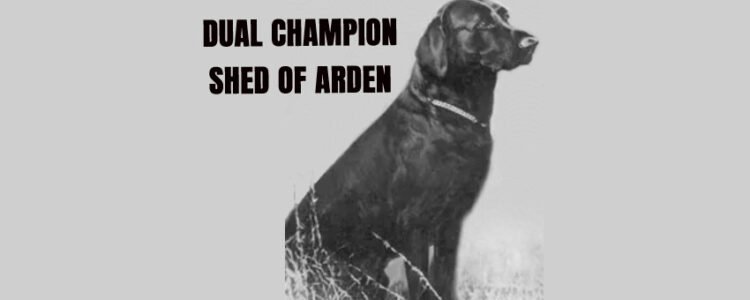
“Shed of Arden’s qualities were of the highest: he epitomized an ideal.
…By those who are knowledgeable, he was considered to have embodied the greatest qualities a Retriever can possess in equal parts: looks, performance, and the priceless gift to transmit these from generation to generation.”
~ Helen Warwick, Lockerbie Labradors
Shed of Arden’s story
3xNFC CFC DUAL CH Shed of Arden is one of the best-known Labrador Retrievers in history, but what do we know about him and his family?
Shed was born March 26, 1939, and bred by William Averell Harriman who owned Arden kennels. Paul Bakewell III of Deer Creek Kennels bought Shed as a young dog.
There’s a story that his siblings were all named for fish and that he was supposed to be Shad of Arden. Due to a clerical error he became Shed instead.
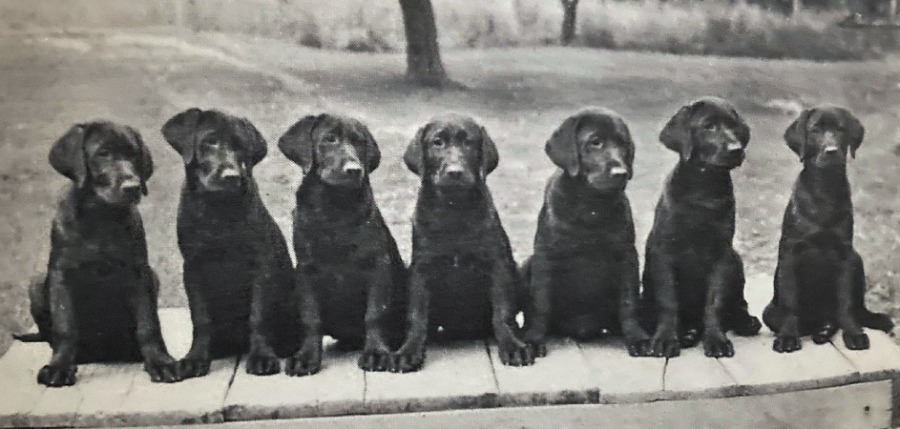
The Arden ‘fish’ litter, including Shed, Bass, Marlin, Trout.
Competition
Show competition
Although Shed often competed in the show ring and field at the same time, he started his career in the show ring. At 14 months old he won Winners Dog and Best of Winners for a 5-point major at the Labrador Retriever Club’s specialty show in 1940. His older brother, CH Earlsmoor Moor of Arden, won Best in Specialty at that show. A week later the brothers repeated their wins at another show with another major for Shed.
He finished his show championship 15 months later with two Best of Breed wins and a Group 4th.
Field Competition
Retriever field trials in America were still in their infancy when Shed was born. It was only nine years since his uncle, NFC Blind of Arden, won the first field trial.
Shed started his field career with a Derby second at 20 months, still owned by his breeder.
The next year he started earning points in field competition. By the fall of 1942, he had finished his field championship to become a dual champion. He also qualified for the National Retriever Championship.
National Championship 1942
As a 3-year-old, Shed won his first National Championship. He was handled by Lt. Bakewell who was on leave from the Navy Air Corps.
Madison, Wisconsin hosted the National on December 4-6, 1942. The weather was cold. “The Yahara River and adjoining marshes which ordinarily afforded everything desired for water tests were frozen solid…. This necessitated moving the water tests to the University of Wisconsin property along the shores of Lake Mendota. Heavy ice floes made it dangerous for dogs to get into the water. Several refused to enter, others only after repeated commands.” 1
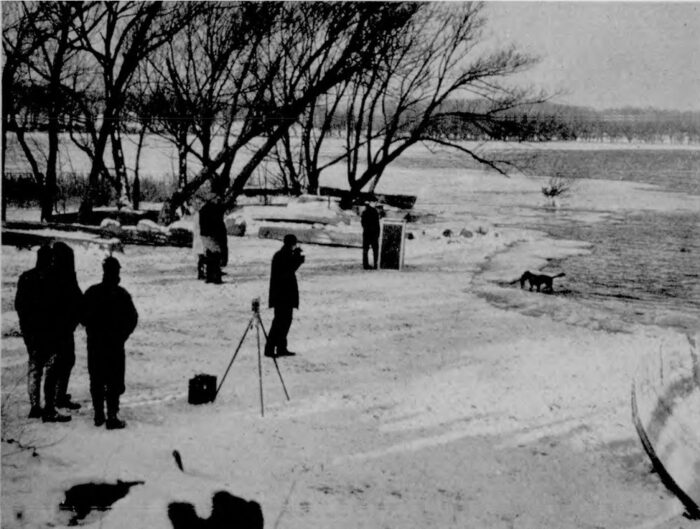
Icy conditions on Lake Mendota. Photo courtesy American Kennel Gazette.
“The weather was bitter and difficult on the great gallery, but it was weather to be expected in the final week of the Wisconsin duck hunting season and no dog who could not meet these conditions could rightfully aspire to the national title.” 2
“To win, Shed had to show supreme ability to bound over frozen hummocks in quest of pheasants and to break sheets of ice in swimming after ducks. In fact, it is hard to imagine more trying conditions than those which the dogs, their handlers and the gallery faced during the three days of the stake. The thermometer was never far from zero, and frequently was below that mark….” 3
Eighteen dogs started, but only five finished, including two owned by Bakewell – Shed and FC Stilrovin Super Speed. The other finishers were FC Hiwood Mike, Patricia of Roedare, and Seaborne’s Black Prince.
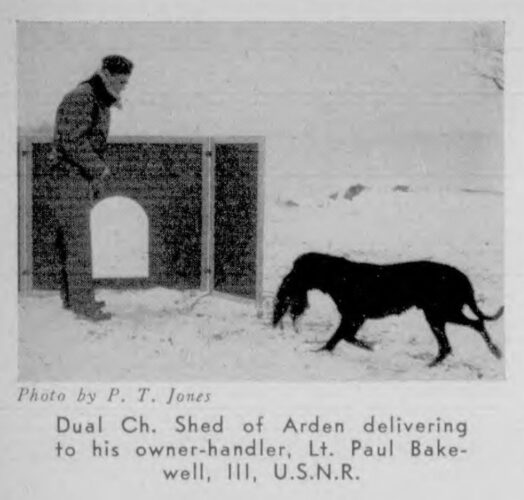
Shed of Arden delivering a bird. Photo courtesy American Kennel Gazette.
“Throughout the meeting Shed did everything asked of him, and did it brilliantly. Probably the thing that most pleased the gallery was the way that willingness was demonstrated when, in the final water test, he never hesitated a minute in crashing his way out through brittle ice…” 4
National Championship 1943
Shed won the National Championship again the next year. He was handled by Clifford H. Wallace because Lt. Bakewell was on active duty.
Bourbon, Missouri hosted the stake on December 3-5, 1943. Twenty dogs started, of those 15 were Labs and five were Goldens. It took two extra series to determine the winner between two dogs – Shed and a Golden Retriever named FC Stilrovin Super Speed. Both dogs were owned by Lt. Bakewell.
Cotton Pershall trained Shed until until it was time to join the Army. At that point, Clifford Wallace took over and guided Shed through the grueling tests in Missouri.
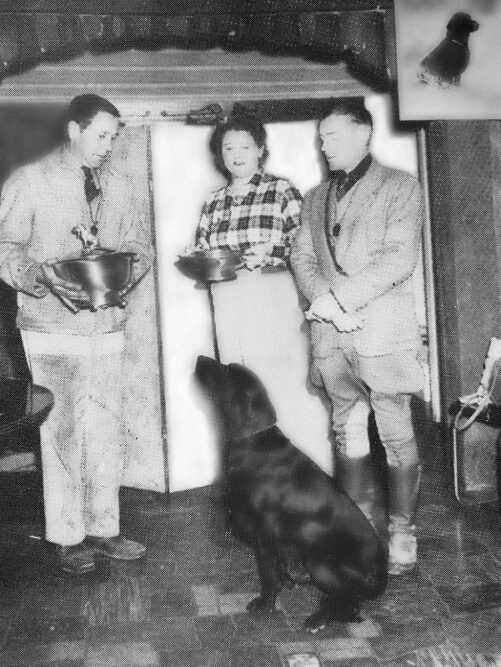
Mrs. Bakewell with Shed and handler C.H. Wallace. Presenting the trophy was M.B. Wallace Jr, trail chairman. Photo courtesy American Kennel Gazette.
Shed didn’t compete in the 1944 National. However, he did travel to Vancouver, British Columbia in October where he finished his Canadian Field Championship.
National Championship 1945
World War II ended in 1945 after Germany surrendered in May and Japan surrendered in September. That November Shed and Bakewell were back to compete in the National Championship. This time it was held at Shelter Island, Long Island, New York, which meant a daily ferry ride from Riverhead. The stake was held on November 30-December 2, 1945.
The first day brought blinding snow and sleet which limited the day to only one series. The second day was cold and windy with high tides and northerly winds. The judges ran land tests in the morning and water tests as the tide ebbed. Despite the conditions, only six dogs were dropped.
Although Shed was a finalist, the judges awarded the win to Black Magic of Audlon.
National Championship 1946
Shed was now seven-years-old, but he continued competing at trials around the country. At a trial in Oregon he had a 300-yard blind retrieve across the tip of a lake for a shackled duck planted several yards off the shore. He was one of only six dogs to complete the series.
In the fall of 1946, Shed reclaimed his crown and is the only three-time winner of the National Championship. It was held on December 6-8. The grounds were good at Crab Orchard Lake, Herrin, Illinois, as was the weather. This is a coal mining area, and the mines were on strike at the time of the National. “… the gallery was augmented by many hundred miners who came to see the event. Some estimated the gallery at 10,000. Traffic presented a bit of a problem.” 5
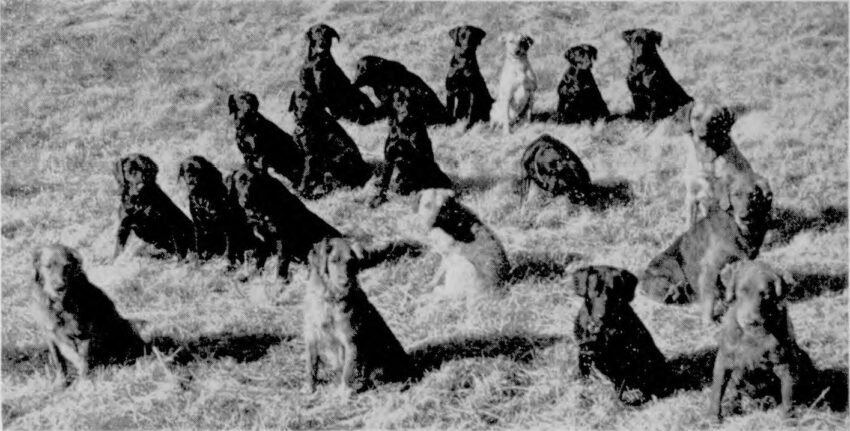
The 20 dogs entered in the 1946 National Championship Stake. Photo courtesy American Kennel Gazette.
Twenty dogs started the stake and eight finished.
In the final series, Shed faced off against three tough competitors. They were his kennel mate, Dual Champion Little Pierre of Deer Creek, plus FC Scoronine of Deer Creek, and a Golden retriever named Stilrovin Nitro Express.
“Scoronine led the field until the last day, then refused to plunge into the 45° water. Now it was Shed’s turn.
“In the toughest test, he had to find two dead ducks which had been planted among the rushes across a 150-foot-wide bay. Shed waited calmly at the water’s edge until he got the signal from Bakewell. Then he plunged bravely into chilly Crab Orchard Lake, but not with his old zip.
“… One-third of the way across, Shed’s black head turned at a whistle from Bakewell to get directions. He entered the cattails just six feet from where the mallard was hidden, sniffed for a second, found his bird. A few minutes later, Shed did it again, and won his third U.S. championship.” 6
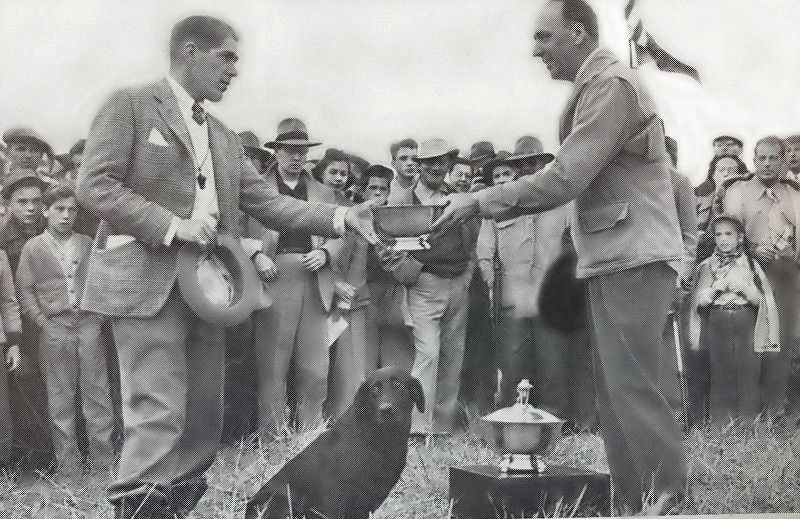
Paul Bakewell received the championship trophy for Shed’s third national championship win.
National Championship 1947
Shed ran the National Championship one more time. The 1947 National was again held at Crab Orchard Lake, Herrin, Illinois. The weather was good with only occasional light rain. Twenty one dogs started, but only four dogs finished. These dogs completed the tenth – and the eleventh – and the twelfth series in an effort to determine the winner. The final series was completed in near darkness.
These dogs were:
FC Black Panther, owned by CW Carlson
FC Black Roland of Koshkonong, owned by Wesley Jung
FC Bracken’s Sweep, owned by DE Pomeroy
DUAL CH & 1942 , 1943, 1946 NATL CH Shed of Arden, owned by Paul Bakewell
Bracken’s Sweep, handled by TW “Cotton” Pershall, was crowned the winner.
Shed’s Family
| CH Raffles of Earlsmoor | Thatch of Whitmore CCW | Eng DUAL CH Titus of Whitmore |
| Tee of Whitmore | ||
| Task of Whitmore CCW | Toi of Whitmore FTW | |
| Eng CH Teazle of Whitmore | ||
| FC Decoy of Arden | Odds On FTW | The Favorite FTW |
| Jest | ||
| Peggy of Shipton FTW | Ronald of Candahar | |
| Gehta of Sigeforda |
His parents
Shed’s sire, Raffles, was Dr. Samuel Milbank’s first Labrador although dogs were always part of his life. His father, Dr. Milbank, Sr., bred Chesapeake Bay Retrievers and terriers.
A Scottish surgeon started the junior Dr. Milbank into Labradors when he found and shipped Raffles to him. According to Helen Warwick in The Complete Labrador Retriever, importing Raffles “started a collaboration of Dr. Milbank and W.A. Harriman that molded the fortunes of the Arden kennel, setting a precedent for quality that has never been equaled by any other Labrador Kennel in America.”
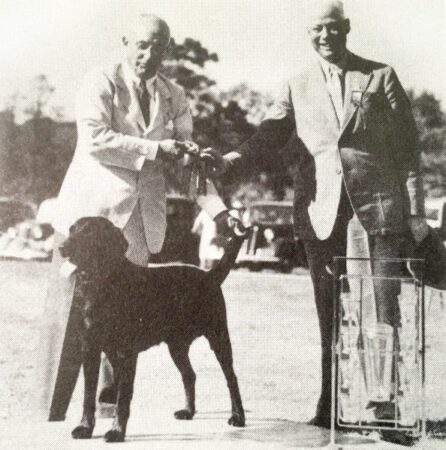
Show champion Raffles of Earlsmoor
Decoy, Shed’s mother, was the second Lab to earn a field trial championship in America. Her full brother, Blind of Arden was the first to earn a field trial championship and also won the first US retriever field stake in 1938.
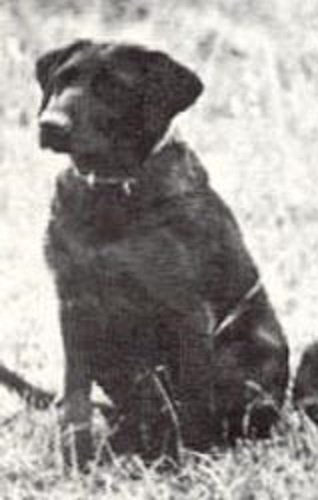
Field champion Decoy of Arden
Shed descends multiple times from well-known Labs such as English field trial champions Flapper and Peter of Faskally plus the first dual champion Banchory Bolo.
His siblings
Some of Shed’s full siblings included:
- CH Earlsmoor Moor of Arden
- CH Earlsmoor Marlin of Arden
- DUAL CH Gorse of Arden
- DUAL CH Braes of Arden
- CH Bass of Arden
Half siblings included:
- FC Gun of Arden
– Grandsire of 2xNFC Spirit Lake Duke and great-grandsire of DUAL CH CFC Ridgewood Playboy and CH Whygin Gentle Julia Of Avec - Marvadel Cinders
– Dam of Can DUAL CH Coastal Charger of Deer Creek and NFC AFC Marvadel Black Gum
His titled offspring include:
CNFC FC AFC Ardyn’s Ace of Merwalfin
FC AFC Bigstone Bandit
CFC Chanbar Jigaboo ***
CH Chukker of Bonniehurst
NFC AFC Creole Sister
FC Dacity Bill
CH Dauntless of Deer Creek
CH Deer Creek Black Ace
FC Firelei’s Hornet
FC CFC Jibodad Gypsy
CFC Nelson’s Black Prince
FC Pickpocket for Deer Creek
CH Snikeb’s Cookie
CH Trixie’s Black Cargo ***
CH Wardwyn Jackpot
Shed’s descendants at Justamere Ranch:
Chip descends multiple times from Shed. Those bloodlines include:
Dual and field champions –
NFC Dual CH CFC Bracken’s Sweep
Dual CH Grangemead Precocious
CFC Chuck of Bracken
FC Dacity Bill
FC Freehaven Muscles
FC Gilmore’s Peggy
FC Shoremeadow Tidewater
FC AFC Tar Baby of Hilly Hill
Dee also descends multiple times from Shed. Those bloodlines include:
Dual champions –
Dual CH AFC Alpine Cherokee Rocket
Dual CH Cherokee Buck
Dual CH Grangemead Precocious
Dual CH Ridgewood Playboy
Can Dual CH Coastal Charger of Deer Creek
Can Dual CH Dart of Netley Creek
Field champions –
FC AFC Air Express
FC Beautywood’s Carbon Copy
CNFC FC AFC Belle of Zenith
FC AFC Bigstone Bandit
NAFC FC Bracken’s High Flyer
FC AFC Canis Major’s River Bear
NFC AFC CFC Cork of Oakwood Lane
FC AFC Cougar’s Rocket
CFC Crevamoy Iron Duke
2xNAFC FC Dee’s Dandy Dude
FC Deer Creek’s Bewise
2xNFC CNFC AFC Del-Tone Colvin
NAFC FC Dude’s Double or Nothin’
FC Firelei’s Hornet
FC Freehaven Muscles
FC Gilmore’s Peggy
FC AFC Ginger’s Choc August
FC AFC CFC Grady’s Shady Ladee
NAFC FC CFC Guy’s Bitterroot Lucky
AFC Jilly Girl
FC AFC Les Coup De Grace TD
FC Luka of Casey’s Rocket
FC Martens Mister Nifty
FC AFC Mon Tour De Force
FC Mueller’s Stormy Canada
FC Nelgard’s Counter Point
CFC Nelson’s Black Prince
FC AFC Paha-Sapa Chief II
AFC Penny Girl
FC AFC Raider’s Piper Cub
FC AFC Rip’s Bingo
2xNAFC 3x CNFC FC River Oaks Corky
NAFC FC River Oaks Rascal
FC AFC River Oaks Way-Da-Go Rocky
FC Roy’s Rowdy
FC AFC Serrana Sootana of Genesee
FC AFC Shed’s Prince of Garfield
NFC 2xNAFC Super Chief
FC AFC Tar Baby of Holly Hill
2xCNFC AFC Tar Baby’s Little Sweet Stuff
FC AFC CFC Trieven Thunderhead
FC AFC CFC Triple Echo
FC AFC Trumarc’s Raider
AFC Westwinds Shadow of Hope
2x NFC Whygin Cork’s Coot
CNFC FC AFC Yankee Clipper of Reo Raj
FC Zipper Dee Doo
Show champions –
CH Dauntless of Deer Creek
CH Rupert Dahomey
CH Whygin Poppitt
CH Woodcroft Daisy
Conclusion
During his career, Shed earned both US and Canadian Field Championships and a US show championship which qualified him as a DUAL champion. He also ran in five national field championships – winning three times and finishing as a finalist the other two times. At one point his owner turned down an offer to buy him for $10,000 (equivalent of about $150,000 today).
Sometimes the descriptions of field trials from years ago sound more like hunt tests. Don’t be fooled. The tests were real hunting scenarios. On the East Coast, birds were often thrown from a boat well out in the mouth of a bay. An outgoing tide could carry that bird out even farther. Trials were held even if the temperature was below zero, but jumping into frigid water and breaking ice was one of Shed’s specialties. A trial he won as a seven-year-old, included “a 300-yard blind retrieve across the eastern tip of the lake for a shackled duck that was planted several yards from the opposite shore.” 7
He was a good ‘un.
3xNational Field Champion, Canadian Field Champion, Dual Champion Shed of Arden
Whelped: March 26, 1939
Owner: Lt. Paul Bakewell III, Deer Creek Kennel
Breeder: W. Averill Harriman, Arden Kennel
Registration: A-330767
Abbreviations:
CH – Show champion
FC – Field trial champion
NFC – National field trial champion
CCW – English Conformation Certificate winner (not a title)
FTW – English Field trial winner (not a title)
CFC – Canadian field champion
Notes:
[1] The National Retriever Field Trial Club, 1941-1960, 62.
[2] “Victory Well Earned”, New York Times December 12, 1942
[3] “Dual Ch. Shed of Arden Wins Retriever Championship”, American Kennel Gazette, January 1943, 65.
[4] Ibid
[5] The National Retriever Field Club, 1941-1960, 79.
[6] “Sport: An Old Dog’s Day”, Time magazine, December 23, 1946
[7] “Shed of Arden Wins Oregon Open All-Age”, American Kennel Gazette, June 1946, 92.
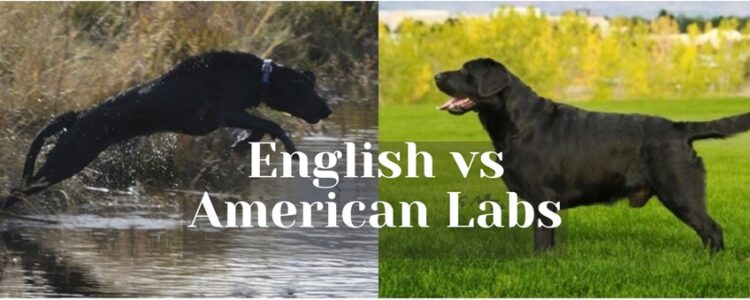
As a long-time Labrador fan, I’ve owned both the English vs American styles. Some people call them “show” or “field” Labs, as that can be less confusing.
So, what makes one dog an English Lab and another an American Lab? This guide will explain what happened.
Early Labradors in America
From the 1930s when the first Labs were imported through the 1970s, field Labs and show Labs were virtually the same. It was common for show dogs to be bred to field dogs. Even Ebonstar Lean Mac, one of the best-known field trial Labs, descends from show dogs.
Often, individual dogs were a bit better at one sport or the other, but some were good at both. During that time there were 37 Labs that earned both a show championship and a field championship to become Dual Champions.
What Caused The Split
In the 1970s and 1980s, a second wave of British imports began. Some of these dogs were heavier-bodied with blocky heads. Show fanciers in America flocked to them hoping to breed the next big winner.
Meanwhile, field trials were changing. The landscape here is bigger and more open than in England so dogs needed to go farther and faster to win.
Thus started the divergence. Show dogs became shorter and heavier. Field dogs became taller and lighter.
Because show dogs of that time had imported English blood, they were called “English Labs.” Originally only the imported dogs were called English, but over time all show-type Labs were called English. Other Labs were called American.
English vs American – Physical Differences
During three decades as the most popular breed in America, striking differences developed between the English vs American styles.
These physical differences aren’t just cosmetic, they reflect the different purposes for which the English vs American Labs were bred.
English Labs were bred for show rings, while American Labs were developed for their hunting and field trial abilities.
Energy level
Both English and American Labs are highly trainable, but their different energy levels can affect their training needs.
English Labs:
- Often easier to train for basic obedience
- May be more patient with children and other pets
- Good for therapy work and as emotional support animals
American Labs:
- Great at advanced training and complex tasks
- Thrives on plenty of physical and mental stimulation
- Good for active families and outdoor enthusiasts
Temperament
Both English and American Labs share the Labrador friendliness and eagerness to please. However, there are some slight differences in their temperaments.
English Labs are often calmer and more laid-back. They are great for families and first-time dog owners and they enjoy being a “couch potato.”
American Labs often have higher energy levels and are more athletic. They enjoy doing something, whether hunting, competing, or fetching a ball in the yard. They can also be great family dogs.
Different Purposes
The differences in appearance, energy level, and temperament between English vs American Labs are due to their varied purposes.
English Labs are bred for the show ring with a priority on their structure and looks. American Labs are bred for hunting and field trials where they need athleticism, stamina, and working ability.
Most Labs fall somewhere in between with traits from both types.
English vs American Labradors aren’t the only choices
Instead, it’s a continuum from short and heavy with a large head to tall and slender with a narrow head.
Some show males look more like a Newfoundland or a wrinkled Shar Pei. They are almost a cartoon version of the original Labs that were bred to be field dogs. However, I am seeing a shift to a more moderate dog in the show ring. An exception is at the Labrador-only shows where structure is generally excellent, but more-is-better often reigns.
Some field-bred females have the height, slender legs, and head shape of a Whippet. These dogs can spend all day hunting or retrieving at tremendous distances and still want more. They are often bred for trainability, marking ability, and intelligence rather than their looks.
In between, there are dogs that still look like a classic Labrador. Classic Labs are dogs from early in the breed’s history until the breed really started to diverge in the 1960s.
Here are a couple of classic Labs:
First, is Dual CH NFC AFC Can CH Shed of Arden, a great Lab of the past. He not only earned a show championship in two countries, but was also a three-time National Field Champion! Shed was not so tall and lanky as many of the field dogs of today, nor was he so blocky as most of the current show dogs.
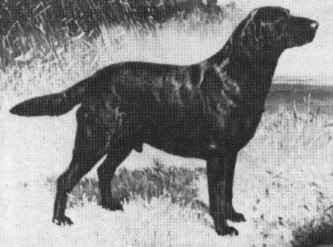
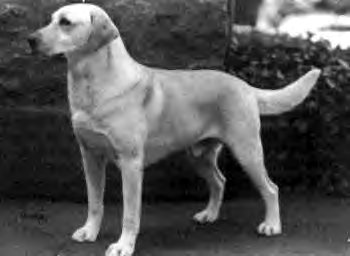
Another great from the past was CH Shamrock Acres Light Brigade. “Briggs was an outstanding show dog and sire. He produced 93 AKC Champions and won 12 Best in Show awards and 75 Sporting Group placements.” Compared to show dogs today he had longer legs and less substance, but look at those shoulders and the balance! I’d bet he moved exceptionally well.
Additionally, many people just want a Labrador and don’t breed for a specific style. The breed’s versatility and adaptability allowed it to meet many needs and yet keep it’s intelligence, friendliness, and trainability.
Choosing the Right Lab for You
When choosing between an English vs American Lab, consider your lifestyle and what you’re looking for in a dog.
- Activity Level: Do you want a more laid-back dog or an energetic exercise partner?
- Living Space: Do you have a large yard or live in an apartment?
- Time Commitment: How much time can you spend training and exercising?
- Family Situation: Do you have young children or other pets?
Remember, these are general guidelines and some dogs might be different. Always meet the dog and, if possible, its parents before deciding.
You can also check out the AKC Breed Standard to read about the “perfect” Labrador.
The differences between these types of Labs allow dog lovers to find a Lab that fits their lifestyle. Whichever you choose, you’ll have a great companion with the qualities that make Labradors one of the most popular breeds worldwide.
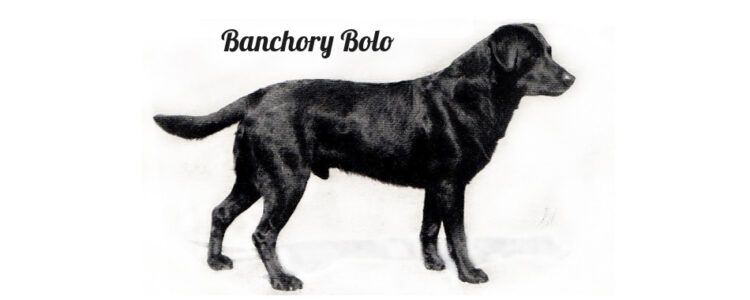
Banchory Bolo was the first-ever Dual Champion Labrador Retriever.
His is an interesting story. Not just rags to riches, but riches to rags and back to riches. Pull up a chair and learn about the dog who still has an influence on Labradors over one hundred years after his birth.
Bolo’s early years
Bolo was two years old when Mrs. Quintin Dick (later Lorna, Countess Howe) entered his life. She had owned his sire, Scandal of Glynn, who was “a charming and beloved companion and a great game-finder.”
When Scandal died, she wanted to find a dog to replace him. Unfortunately, none of the other dogs she owned could fill the gap his passing caused.
Her husband, Quintin Dick, suggested a son by Scandal. However, during the First World War breeding was restricted and Scandal had only sired one litter. In it, there were 13 puppies of which 12 were females.
The only male – originally named Caerhowell Bully – had been given away by his breeder. When Lorna(1) found him, he was given to her with the advice that if she didn’t want to keep him to have him put to sleep. They told her the dog was “hopeless” and had “an evil temper.”
When she picked him up at the train station, she realized what she’d been told was true. The dog was unkempt, had sores on his ears and he growled at her through the heavy muzzle he wore. Although he had a wonderful pedigree, she debated: Should she keep him or put him to sleep as she’d been advised?
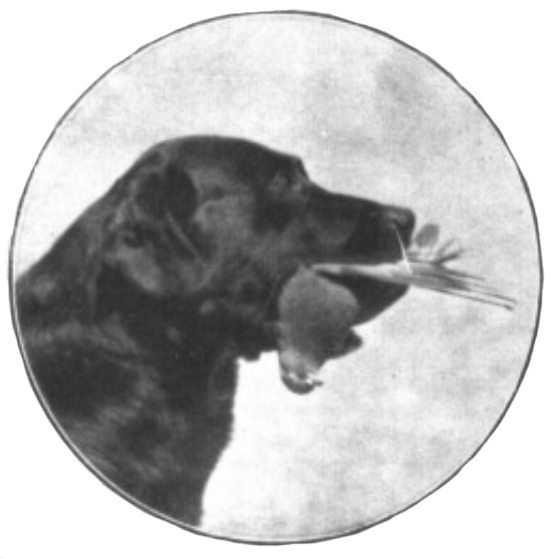
Banchory Bolo
Lorna and Bolo
She must have had a kind heart as she took him home with her. After taking off the muzzle and chain, she turned him loose in a spacious room, but he was distrustful and surly. He wouldn’t come to anyone and it took quite a while to catch him.
Something must have happened to him in his earlier life. Heavy-handed trainer? Malicious kennel help?
He avoided people. When turned out for exercise, he was hard to catch. How could he be trained when he was so distrustful of people? What could soothe the savage beast?
It turns out it wasn’t music, but Lorna’s gentle care. When he became seriously ill, she nursed him back to health. During that time, he realized she was someone he could trust. As he recovered he became devoted to her and was always at her side.
The stirrings of greatness
When he started in training, Lorna found he had “a natural love of retrieving, an excellent nose, and a perfect mouth.” However, he also had two failings: he loved chasing rabbits and was terrified of cracking whips. One day when a stable boy happened to crack a whip near him, the fear took over and Bolo blindly sought escape. A tall, spiked gate didn’t stop him from running.
He returned early the next morning, covered in blood. “He had two very deep wounds on his chest, a tear three inches long in his groin and his hind leg and hock torn so badly that the bone was visible.” Because a veterinarian was too far away, Lorna stitched his wounds as he lay still for her.
Her doctoring and subsequent training was well done as the next fall he won a field trial prize. Then he quickly won two field trials and became a field champion. Two years later he also finished his show championship and became the first Dual Champion Labrador.
Lorna said, “He had quite the best nose I have ever seen in a dog and with apparently the greatest ease he would collect runner after runner after several other dogs had failed. I have never had a dog with such great natural ability or one so anxious to please me in every possible way.”
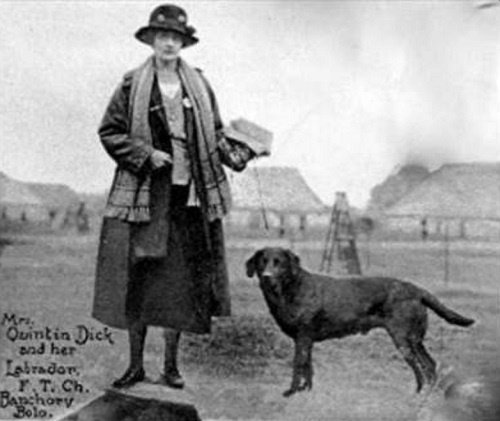
Lorna, Countess Howe and Banchory Bolo
From greatness comes greatness
The genes from several great dogs came together in Banchory Bolo. We have Lord Malmesbury, the Dukes of Buccleuch, and Lord Knutsford (Munden kennels) to thank for their breeding insight and the dogs they produced.
Banchory Bolo’s pedigree:
| Scandal of Glynn | English FTCh Peter of Faskally | Waterdale Gamester |
| Birkhill Juliet | ||
| English FTW Shelagh of Glynn | English FTW Scamp of Glynn | |
| Shelagh of Danesbury | ||
| Caerhowell Nettle | Foxley Kennett | Hirsch’s Ranger |
| Bendysh Bess | ||
| Baker’s Nora | unknown | |
| unknown |
His family
Looking backward in time, Bolo’s sire, Scandal of Glynn, was a son of English FTCh Peter of Faskally. Peter won the International Gundog League’s Championship Stake for retrievers in 1911, but it was his partnership with his handler, Archie Butter, that set him apart from the other retrievers.
Butter realized that if a dog could be guided by his handler, the quicker he would be able to find and retrieve game. To do this, he adapted the methods used by shepherds when handling their dogs using whistles and hand signals. We still use a form of this method today.
Peter of Faskally’s pedigree is filled with dogs from the Munden and Buccleuch kennels. Munden Sixty (born 1897) appears three times in Peter’s pedigree and once more in Scandal of Glynn’s maternal line.
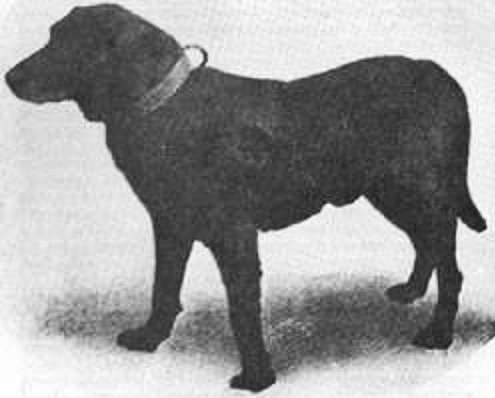
Buccleuch Avon
Sixty’s paternal grandfather, Buccleuch Avon (born 1885), was a gift from the third Earl of Malmesbury to the sixth Duke of Buccleuch.
Avon was sired by Malmesbury Tramp (born 1878) and out of Malmesbury Juno (born 1878). Another male, Buccleuch Ned (born 1882), was also a gift. These dogs were bred to bitches that descended from dogs imported originally by the fifth Duke of Buccleuch.
Another great in Peter of Faskally’s pedigree is Munden Single (born 1899). She was sired by Munden Sixty and descended from Munden, Buccleuch, and Malmesbury dogs. She’s best known for being the first Labrador to win a Challenge Certificate and the first Labrador to run in a field trial.
More Munden, Buccleuch, and Malmesbury
Less is known about Scandal of Glynn’s maternal side. His maternal grandfather, Scamp of Glynn FTW, traces to Buccleuch Ned, the other male gifted by Lord Malmesbury. And his maternal grandmother, Shelagh of Danesbury, is mostly from Munden dogs that trace back to the Buccleuch and Malmesbury kennels.
Even less is known about Banchory Bolo’s mother, Caerhowell Nettle, although her father traces back to Peter of Faskally as well.
Bolo’s legacy
With all the good genes passed down from his ancestors, it’s not surprising that he also produced well. He sired both show champions and field trial champions.
Bolo’s show offspring
In 1921, he was bred to Brocklehirst Nell (owned by Mrs. Dinwoodie) and sired English Ch Banchory Bluff, English FTCh Nith of Halleaths, and Brocklehirst Daisy FTW. Bluff was the maternal grandsire of English FTCh Balmuto Hewildo. Bluff was owned by Lorna.
Also in 1921, he was bred to Murrayfield Bett (owned by Mr. Dinwoodie) and sired English Ch Brocklehirst Donner. This dog was also owned by Lorna.
Yet another litter in 1921, produced English Ch Beningbrough Tangle. He finished his show championship, including winning the CC at Crufts in 1930 and he also won a field trial. So close to being another Dual Champion! He was bred by The Earl of Chesterfield and owned by Lorna. His mother was Thyme, a daughter of English Ch Ilderton Ben.
In 1922, Bolo was bred to a granddaughter of English Ch Ilderton Ben. Her name was Malta of Lunn and was owned by the Earl of Clarendon. In this litter was a female named English Ch Banchory Kelpie, owned by Lorna.
Breeding dogs all but stopped during World War I. This sent the Munden kennel to the edge of extinction. However Lorna “gave Lord Knutsford a puppy on the condition that he should eventually breed her with Dual Champion Banchory Bolo.”
He registered this puppy as Munden Scarcity. Her sire was English Ch Banchory Lucky and her dam was Banchory Betty. In Scarcity’s litter by Bolo, she produced both English Ch Banchory Danilo FTW and English Ch Munden Solo FTW. Lord Knutsford also kept Singer, a bitch, and another bitch was given to His Majesty the King.
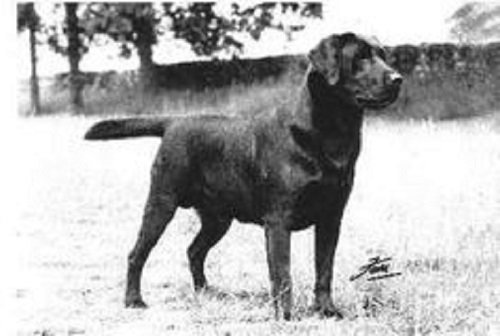
Banchory Danilo
One of Bolo’s best sons
Danilo won 33 Challenge Certificates in the show ring and won the best exhibit in the Kennel Club Show in 1925. He went on to also win two field trial honors in 1924, handled by Lorna. Danilo sired English Ch Drinkstone Pons of Wingan (sire of American Ch Echo of Arden), English Ch Drinkstone Dan, and Haylers Danilo (sire of English Ch Poppleton Black Lancer).
When Danilo’s grandson, Hiwood Risk, was bred to Peggy of Shipton we see some of the Arden dogs, including American National Field Champion Tar of Arden and her offspring – American FC Firelei of Deer Creek, American NFC Black Magic of Audlon, American Dual Ch CFC Little Pierre of Deer Creek.
Danilo’s brother, Munden Solo, also did well at shows. At Crufts in 1927, he competed in ten classes, won six, and placed in three more. The judge wrote of him, ‘If there had been a little more of him in size, I think he would have been very near perfection.’
Bolo sired another English show champion, Banchory Bolo’s Trust, in 1926. His mother was Beaulieu Nance (daughter of English DUAL Ch Banchory Sunspeck).
English DUAL Ch Bramshaw Bob, double-bred on Bolo, won Best in Show at Crufts twice – 1932 and 1933. Lorna bought him from Sir George Thursby and when she took him to Crufts in 1932, Bob won all the classes he was entered in and won Best in Show on the second day.
Lorna said, “Cruft’s Show was, and still is, a great meeting place for gamekeepers. I shall never forget the overwhelming reception they gave Bob when the award was announced; it was so kind of them. They were pleased that a working gundog should receive this much-coveted award.”
Bolo’s field offspring
Bolo was bred to Kirkmahoe Dinah FTW in 1921. This litter included English National FTCh Kirkmahoe Rover, Banchory Corbie FTW, and Choice Of Kirkmahoe FTW.
Banchory Corbie won one Challenge Certificate (show points) and won the 1923 International Gundog League (IGL) Nomination Stake. Then he “broke his shoulder by galloping into a guard post” thus ending his show and field trial career. Lorna described him, “Corbie was in character and temperament all that a Labrador should be. He was highly intelligent, very faithful, a wonderful watch-dog and guard, yet very gentle with children. He had the great game-finding ability which goes with good nose and the brains to use it.”
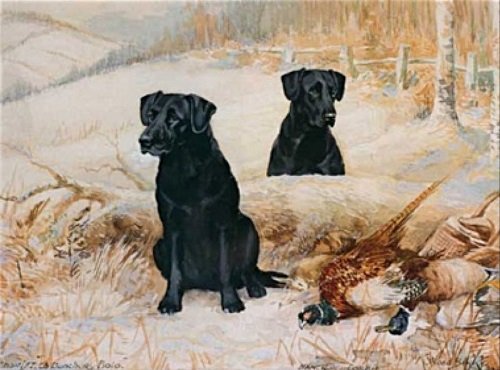
Banchory Bolo and his son, Banchory Corbie
Another Bolo son was born in 1923, Banchory Roger FTW. He was linebred on English National Ch Peter of Faskally and on Munden Sentry.
Another male, English FTCh Balmuto Hewildo, was also double-bred on Bolo. Instead of winning in the show ring, he won the IGL Retriever Championship in 1936. This is comparable to the National Retriever Championship in the US.
In short, Bolo was a great producer.
A legend
Author C. Mackay Sanderson wrote, “Bolo’s coming may be said to have breathed a spirit of new life into the breed, the prestige enjoyed by this dog as a competitive and stud force giving lasting impetus to Labrador fortunes and subsequently his name runs like a golden thread through all the vital streams of progress.”
“The Field wrote of Bolo: ‘If ever evidence were needed of the character of a great dog, and of his influence on the generations following him, it was to be found at the Retriever Championship Trial held at Idsworth last week [December 1932]. Out of fourteen dogs that won prizes, eight were descended from Banchory Bolo.'”
But Bolo also had another legacy – he tended to throw white hairs on the feet. These ‘Bolo marks’ or ‘Bolo pads’ are still sometimes seen on the bottom of the front feet and/or the back of the front pasterns.
Bolo died in July 1927. It was ten years before Lorna was able to give her heart to another dog.
English Dual Champion Banchory Bolo
Whelped: December 29, 1915
Died: July 10, 1927
Owner: Lorna, Countess Howe (AKA Mrs. Quintin Dick)
Breeder: Sir John S Harmood-Banner
Original name: Caerhowell Bully
Registration: KC SB 218AA
1. Although she became Lorna, Countess Howe because of her second marriage, she was known as Mrs Quintin Dick during Bolo’s lifetime. However for the sake of ease, I’ve used her first name here as it’s how she’s known by Lab enthusiasts worldwide.
Abbreviations:
Ch – Show champion
CC – Challenge Certificate (show points)
FCh – Field trial champion
NFCh – National field trial champion
FTW – Field trial winner (not a title)
CFC – Canadian field champion
IGL – International Gundog League
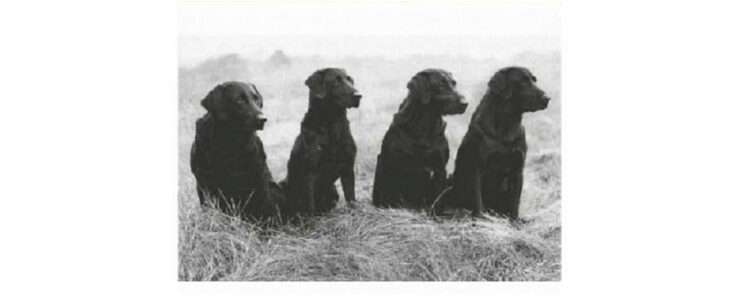
Not only one of 37 Labradors in the US to earn both a show and a field championship, but part of a dynasty. Four Dual Champions in four consecutive generations – 3xNFC CFC Dual CH Shed of Arden, father of Dual CH Grangemead Precocious, grandfather of Dual CH Cherokee Buck and great grandfather of Dual CH AFC Alpine Cherokee Rocket.
HIS BACKGROUND
Precocious was bred and owned by Thomas W. Merritt, a man who spent many years supporting the breed and competition he loved.
- Judged over 50 field trials, including the first National Amateur Stake in 1957 and the National Open (4 times).
- One of the original incorporators of the National Club.
- Past President of the Labrador Club.
- Was a Director of the American Kennel Club.
- President and Editor-in-Chief of the Retriever Field Trial News.
That’s in addition to breeding and owning some of the top Labs of the 1940s and 1950s. He reminds me of Lorna, Countess Howe in their efforts for the breed plus the great dogs they each owned.
Merritt mentioned one of his first puppies was Grangemead Angel who was sired by FC Freehaven Jay. Her mother was a granddaughter of Eng CH Banchory Trueman – another link to Lorna. He bred Angel to Am FC Eng FTCh Hiwood Mike who was a grandson of Eng Dual CH Banchory Painter, yet another link.
Grangemead Sharon, mother of Dual CH Cherokee Buck, was a puppy from the Angel x Mike litter.
HIS PEDIGREE
| 3xNFC CFC Dual CH Shed of Arden | CH Raffles of Earlsmoor | Thatch of Whitmore (Eng CCW) |
| Task of Whitmore (Eng CCW) | ||
| FC Decoy of Arden | Odds On (Eng FTW) | |
| Peggy of Shipton (Eng FTW) | ||
| Huron’s Lady | Am Eng CH Banchory Trump of Wingan | Blenheim Scamp (Eng FTW) |
| Lady Daphne | ||
| CH Bancstone Lorna of Wingan | Eng Dual CH Bramshaw Bob | |
| Eng CH Drinkstone Peg |
The Labrador Retriever was still pretty new to our shores at this time and all eight of Precocious’ great grandparents were British. Shed of Arden was sired by a British import and his maternal grandparents were both British imports. Precocious’ maternal grandparents were also British imports.

CH Raffles of Earlsmoor

3xNFC CFC Dual CH Shed of Arden

FC Decoy of Arden (right)

Banchory Trump of Wingan

Bancstone Lorna of Wingan
PRECOCIOUS GETS HIS START
He was born June 21, 1946, along with at least two litter brothers, Jock of Athabaska and Deer Creek Black Ace. Both brothers finished their show championships.
Merritt remembers Precocious as “a bigger dog than Shed. He was a good marking dog, especially in water and especially strong in water triples.” According to Helen Warwick in The Complete Labrador Retriever.
He was trained and handled by Harold Berentsen. He won his first Open stake at 28 months and finished his field championship about a year later.
During the summer of 1950 he became a show dog and often won Best of Breed. He even placed in the Group a couple of times. Admittedly entries were much smaller than they are today. He won his first Best of Breed on May 7, 1950 and finished his show championship on June 18, 1950. Having already finished his field championship, he became a Dual Champion that same day.
He qualified for and ran in four National Championships – 1948, 1949, 1950 and 1951. He was a finalist in 1950 and 1951.
HIS LEGACY
Some people say he was named Precocious because he sired his first litter at the age of six or seven months. Based on birth dates, he was actually a grand old pup of nine months when he did the deed.
But what a deed! In that one litter with Grangemead Sharon he sired:
DUAL CH CHEROKEE BUCK
– sire of Dual CH AFC Alpine Cherokee Buck
— grandsire of NAFC FC Andy’s Partner Pete
– sire of Ironwood Cherokee Chica
— grandsire of NFC 2xNAFC Super Chief (Hall of Fame), FC AFC Carr-Lab Penrod, FC Chief Black Feather, FC AFC Paha Sapa Warpaint, FC AFC Paha’s Pow-Wow, Spring Farms Lucky QAA
– sire of Luscious Licorice Lass
— grandsire of FC AFC CFC Triple Echo
FC CHEROKEE MEDICINE MAN
FC FREEHAVEN MUSCLES
– sire of FC AFC Paha Sapa Chief II (Hall of Fame)
— grandsire of NFC 2xNAFC Super Chief (Hall of Fame), FC AFC Carr-Lab Penrod, FC Chief Black Feather, FC AFC Paha Sapa Warpaint, FC AFC Paha’s Pow-Wow, Spring Farms Lucky QAA
— grandsire of NAFC FC Rebel Chief of Heber (Hall of Fame) and AFC Jilly Girl
– sire of FC Nelgard’s Counter Point
— grandsire of Dual CH CFC Ridgewood’s Playboy and FC AFC Sand Gold Kim
You can see these boys in the header image – left to right – Grangemead Precocious, Freehaven Muscles, Cherokee Medicine Man and Cherokee Buck.
Unfortunately Grangemead Sharon was given away before her sons were able to prove themselves. Who knows if a second litter of Precocious x Sharon would have equaled or bested the first litter.
Other offspring:
– sire of CFC Highlander’s Buccaneer and CAN CH Highlander’s Diana
— grandsire of Can Dual CH Blyth’s Knave of Spades
– sire of Beautywood’s Creole Jane
— grandsire of Don’s Ginny Soo
— great grandsire of 2xNAFC 3xCNFC FC River Oaks Corky (Hall of Fame)
— grandsire of FC Roy’s Rowdy
And, yes, we have a bit of Precocious in our dogs. Our pretty Dee and all her offspring, including Arwen, Tory and Cotti, trace back to Precocious several times.
1 – Through 2xNAFC FC River Oaks Rascal to Beautywood’s Creole Jane to Precocious
2 – Through 2xNAFC FC River Oaks Rascal to Dual CH AFC Alpine Cherokee Rocket to Precocious
3 – Through Shamrock Acres Juego De Azar to FC Freehaven Muscles AND Dual CH Cherokee Buck to Precocious
4 – FC AFC Raider’s Piper Cub to FC AFC Paha Sapa Chief II to Precocious
5 – Timberlane Cinnamon to 2xNAFC 3xCNFC FC River Oaks Corky to Precocious
6 – Timberlane Cinnamon to Black Beauty of Random Lake to FC Freehaven Muscles to Precocious
7 – Timberland Cinnamon to Muscle Man of Random Lake to Rise and Shine at Duckwind to Precocious
8 – Timberland Cinnamon to Cherokee King Bojo to Precocious
9 – Timberland Cinnamon to Luscious Licorice Lass to Precocious
10 – FC AFC CFC Trieven Thunderhead to FC AFC Paha Sapa Chief II to Precocious
11 – FC AFC CFC Trieven Thunderhead to Ironwood Cherokee Chica to Precocious
12 – FC AFC CFC Trieven Thunderhead to AFC Jilly Girl to Precocious
13 – Dale’s Double Hope to Dual CH CFC Ridgewood Playboy to Precocious
14 – Dale’s Double Hope to FC AFC Serrana Sootana of Genesee to Precocious
15 – Dale’s Double Hope to FC AFC Toni’s Tar to Precocious
16 – Dale’s Double Hope to Ebony Sally of Widgeon Bay to Precocious
17 – Hard Driving Abigail to Cherokee King Bojo to Precocious (twice)
18 – Hard Driving Abigail to Luscious Licorice Lass to Precocious
And Chip too goes back to Precocious. Through Jilly Girl (twice), Beautywood’s Creole Jane (9x), Super Chief (twice), Gunfield’s Super Charger, Paha Sapa Chief II (separate from Super Chief) and Howmor’s Dark Gypsy.
DUAL CH Grangemeade Precocious
Whelped: June 21, 1946
Breeder: Thomas W. Merritt
Registration: S-127563

These are mostly American titles (AKC and UKC/HRC), but there are also some we see from Canada and England.
In the pedigrees I share I try to differentiate between titles earned in the US versus other countries.
For example, CH = AKC show champion, U-CH = UKC show champion, Can CH = Canadian show champion, Mex CH = Mexican show champion, Eng CH = English full show champion, and English Sh CH = English show champion.
Also included are some that are not technically titles because they’re not bestowed by the country’s governing body.
For example, WC and CC are certificates given by The Labrador Retriever Club rather than by AKC.
There are many organizations awarding titles, but these are the main titles we see for the retriever breeds.
FIELD TITLES |
|
|---|---|
| DC or DUAL CH | A Show Champion AND Field Champion – Note: We haven’t had one of these in Labradors since the early 1980s |
| FC | Field Champion |
| AFC | Amateur Field Champion |
| “C” in front of FC or AFC | Canadian Field Champion – sometimes seen as FTCH |
| “N” in front of FC, AFC, CFC OR CAFC | National Field Champion titles |
| Eng FTW | English Field Trial Winner (part of the Eng FTCH, but not actually a title) |
| QAA | Qualified All-Age – means the dog has won enough in the Qualifying stake to compete in the Open or Amateur stakes at field trials, not actually a title (sometimes seen as *** following the name) |
| QA2 | Qualified All-Age 2, recent AKC title for dogs that have twice met the requirements to compete in the Open or Amateur stakes at field trials |
| JH | Junior Hunter |
| SH | Senior Hunter |
| MH | Master Hunter |
| MNH | Master National Hunter – listed as MNH4 or MNH5, etc when the dog has passed the Master National more than 3 times |
| SHR | Started Hunting Retriever (HRC/UKC title) |
| HR | Hunting Retriever (HRC/UKC title) |
| HRCH | Hunting Retriever Champion (HRC/UKC title) |
| GRHRCH | Grand Hunting Retriever Champion (HRC/UKC title) |
| UH | Upland Hunter (HRC/UKC title) |
| CPR | Certified Pointing Retriever (APLA title) |
| APR | Advanced Pointing Retriever (APLA title) |
| MPR | Master Pointing Retriever (APLA title) |
| GMPR | Grand Master Pointing Retriever (APLA title) |
| WC | Working Certificate (LRC certificate) |
| WCX | Working Certificate Excellent (sometimes awarded by local breed clubs) |
SHOW TITLES |
|
|---|---|
| DC or DUAL CH | A Show Champion AND Field Champion – Note: We haven’t had one of these in Labradors since the early 1980s |
| CH | Conformation Show Champion |
| Pointed or Major pointed | The dog has won in the show ring, but is not yet a champion – not actually a title |
| GCH | Grand Champion – also GCHB Bronze, GCHS Silver, GCHG Gold, GCHP Platinum |
| U-CH | UKC Conformation Show Champion |
| U-GRCH | UKC Conformation Show Grand Champion |
| Eng CH | English Show Champion w/field qualification certificate or Eng Sh CH if the dog qualified in the show ring, but has not qualified in the field (approximately WC equivalent) |
| Eng CCW | English Challenge Certificate Winner (part of the Eng CH, but not actually a title) |
| BIS | Best in Show (achievement, not a title) |
| BISS | Best in Specialty Show (achievement, not a title) |
| BPIS | Best Puppy in Show (achievement, not a title) |
OBEDIENCE TITLES |
|
|---|---|
| CGC | Canine Good Citizen |
| CGCA | Advanced Canine Good Citizen |
| BN | Beginner Novice |
| CD | Companion Dog |
| GN | Graduate Novice | CDX | Companion Dog Excellent |
| GO | Graduate Open |
| UD | Utility Dog |
| UDX | Utility Dog Excellent |
| OM | Obedience Master |
| OGM | Obedience Grand Master |
| OTCH | Obedience Trial Champion |
| NOC | National Obedience Champion |
RALLY TITLES |
|
|---|---|
| RN | Rally Novice |
| RI | Rally Intermediate |
| RA | Rally Advanced |
| RE | Rally Excellent |
| RM | Rally Master |
| RAE | Rally Advanced Excellent |
| RACH | Rally Champion |
| RNC | Rally National Champion |
TRACKING TITLES |
|
|---|---|
| TD | Tracking Dog |
| TDU | Tracking Dog Urban |
| TDX | Tracking Dog Excellent |
| VST | Variable Surface Tracking |
| CT | Champion Tracker |
AGILITY TITLES |
|
|---|---|
| ACT1 | Agility Course Test – Introduction to Agility |
| ACT2 | Agility Course Test – in between Introduction and Novice levels |
| NA | Novice Agility |
| NAP | Novice Agility Preferred |
| NAJ | Novice Agility Jumper |
| NJP | Novice Agility Jumper Preferred |
| OA | Open Agility |
| OAP | Open Agility Preferred |
| OAJ | Open Agility Jumper |
| OJP | Open Agility Jumper Preferred |
| AX | Agility Excellent |
| AXP | Agility Excellent Preferred |
| AXJ | Excellent Agility Jumper |
| AJP | Excellent Agility Jumper Preferred |
| MX | Master Agility Excellent |
| MXP | Master Agility Excellent Preferred |
| MXJ | Master Excellent Jumper |
| MXP | Master Agility Jumper Preferred |
| MACH | Master Agility Champion |
| PACH | Preferred Agility Champion |
| AGCH | Agility Grand Champion |
| NAC | National Agility Champion |
| U-AGI | Agility I (UKC title) |
| U-AGII | Agility II (UKC title) |
| U-ACH | Agility Champion (UKC title) |
| U-ACHX | Agility Champion Excellent (UKC title) |
VERSATILE COMPANION TITLES |
|
|---|---|
| VCD | Versatile Companion Dog |
| VCCH | Versatile Companion Dog Champion |
TRICK DOG TITLES |
|
|---|---|
| TKN | Trick Dog Novice |
| TKI | Trick Dog Intermediate |
| TKA | Trick Dog Advanced |
| TNP | Trick Dog Performer |

